
- Switch skin

In-depth: From spotlight to the shadows: Ethiopia’s tourism odyssey hangs in the balance

By Biruk Alemu @Birukalemu21
Addis Abeba – In the heart of East Africa, Ethiopia unfurls a mosaic of marvels recently thrust into the limelight by UNESCO’s accolades, signaling a tourism renaissance. From the towering majesty of the Bale Mountains to the serene retreats of Lepis Eco Tourism Village, the nation’s canvas is rich with the strokes of history and the vibrant hues of cultural festivities like Shawwal Eid.
Ethiopia is gradually placing its bets on the allure of its rich cultural tapestry and breathtaking landscapes, especially after Prime Minister Abiy Ahmed assumed power in 2018. The current administration is trying to champion the hospitality and tourism sector, steering it into the limelight as a key driver for growth and prosperity.
With a series of government-led initiatives designed to elevate the tourism experience, Ethiopia is not only trying to beckon travelers from around the globe but also paving the way for a surge in local economic opportunities.
The inauguration of the Halala Kela Resort last year represents a critical element of Prime Minister Abiy’s administration endeavor designed to optimize the utilization of the area’s natural resources, thereby facilitating the growth of greenery attraction sites nationwide.
The recent initiatives, prominently featuring mega projects such as the Chebera Churchura Elephant Paw Lodge, also occupy a central role in the enterprises spearheaded by the government.
Last week , Prime Minister Abiy inaugurated the awe-inspiring Chebera Churchura Elephant Paw Lodge, a cornerstone of his administration’s ambitious ‘Dine for Ethiopia’ mega project.
Nestled in the verdant heart of the Dawuro Zone in South West Ethiopia Regional State, this luxurious retreat emerges as a dazzling showcase of Ethiopia’s rich natural endowments, inviting the world to witness the country’s unfolding renaissance in eco-tourism.
Yet, beneath the allure, a specter of unrest casts a long shadow, threatening to dim the burgeoning promise of tourism. As whispers of uncertainty deter would-be explorers, the urgency for peace grows, lest the world remain deprived of Ethiopia’s full splendor.
Despite significant investment in tourism initiatives, Ethiopia confronts considerable challenges, according to industry players. As international tourism experiences a resurgence in the aftermath of the pandemic, ongoing regional conflicts pose a risk to Ethiopia’s emergence as a leading travel destination. An authority in the field revealed to Addis Standard, “The potential is undeniable, but instability acts as a handbrake on progress.”
Research indicates that the hospitality industry was formerly a pivotal element in Ethiopia’s economic advancement, contributing significantly to the nation’s economic growth. It was instrumental in creating jobs, generating income, accruing foreign exchange, and providing social advantages.
Subsequent to 2019, the sector has encountered a multitude of challenges, including the COVID-19 pandemic, domestic conflict, drought conditions, and fiscal vulnerabilities. The World Travel & Tourism Council ‘s most recent analysis highlights that Ethiopia’s travel and tourism sector has undergone marked volatility from 2019 to 2022, largely as a result of the worldwide COVID-19 health crisis and ongoing internal strife.
Conflicts, not merely local disturbances, ravage the tourism sector.” Nahom Admasu, managing director of Pleasure Ethiopia Tour and Travel Agency
In the year 2019, the travel and tourism sector was a substantial contributor to Ethiopia’s economy, representing 6.3% of the gross domestic product (GDP). By the year 2022, the sector’s direct contribution to GDP had reached ETB 329.7 billion (equivalent to USD 6.3 billion), which constituted 5.6% of the total economy. This figure indicated a recuperation from the decline witnessed in 2020, yet it remained a diminution from the levels seen in 2019.
The employment scenario within Ethiopia’s travel and tourism sector also experienced a decline in 2022 when contrasted with 2019 figures. As per the World Travel & Tourism Council’s report, the sector directly sustained 645,113 jobs in 2022. While this number is substantial, it falls short of the employment levels recorded during the pre-pandemic era.
From prominence to uncertainty
Industry experts and stakeholders interviewed by Addis Standard have also depicted the grim state of affairs for the tourism sector, attributing its downturn to persistent conflicts and instability across several regions. They have highlighted a marked decrease in the number of tourists, observing that current visitors are predominantly those attending conferences in Addis Abeba.
This decline is further exacerbated as numerous nations have enacted travel restrictions on Ethiopia, citing concerns over the lack of security in different parts of the country.
The resurgence of conflict involving the non-state militia, Fano, instigated by alterations in regional security arrangements, has drained optimism from the once-bustling locales of Gondar and the tranquil trails of Lalibela.
A local tour guide, speaking under the weight of the current tensions, stated, “Peace, not visitors,” reflecting the stagnation that has gripped the tourism sector.
While the tour guide acknowledged the region’s wealth of attractions, including Gondar’s historic sites, the Northern Mountains, the churches of Lalibela, and Lake Tana in Bahir Dar, he voiced deep-seated apprehensions regarding the tourism industry’s trajectory.
He warned that should the unrest and instability persist, the livelihoods of numerous individuals employed within the industry could be imperiled, potentially leaving them without the means to support their families.
“Peace is the lifeline of the tourism industry,” Nahom Admasu, managing director of Pleasure Ethiopia Tour and Travel Agency, stressed with a sense of immediacy.
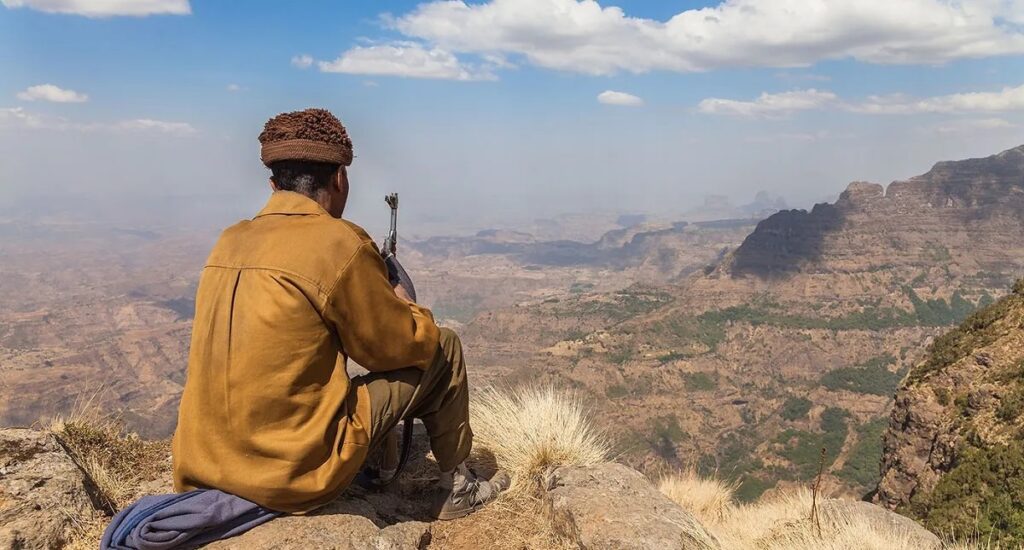
As an active participant in the preeminent Ethiopian Tour Organizations Association, Nahom has directly observed the severe repercussions that even minimal unrest can have on the sector. According to him, the cascade of flight cancellations, unoccupied accommodations, and quiet dining establishments are indicative of foregone reservations, the impact of which resonates down the entire tourism value chain, affecting entities from thriving airlines to service providers.
“Peace is the missing polish for Ethiopia’s tourism crown,” lamented Nahom, who observed that tourists stay away, leaving not just empty streets but empty coffers.
“Foreign currency, the lifeblood of development, slips through our grasp, deepening our economic woes,” emphasized Nahom. “Conflicts, not merely local disturbances, ravage the tourism sector.”
Nahom indicates the travel restrictions imposed due to the Tigray War severely impeded tourist arrivals, and the widespread effects of instability led to the closure of tour operations and the exodus of essential professionals. With Ethiopia’s reputation compromised, he says the endeavor to attract tourists has become an exceedingly difficult challenge.
Fitsum Gezahegn, director of the Ethiopian Tour Organizations Association, an entity dedicated to promoting the nation and drawing tourists, has acknowledged the sharp decline in tourist arrivals as a consequence of Ethiopia’s persistent conflicts. “Ethiopia’s vibrant tapestry of ancient wonders and bustling markets lies tragically muted, its colors bleeding away under the weight of ongoing conflicts.”
Despite the presence of a few daring visitors who manage to overcome the hurdles of travel to Ethiopia, Fitaum maintains that their numbers are merely a fraction of what the country could potentially attract. “High travel costs, limited availability, and gnawing safety concerns keep the majority of adventurers at bay.”
Additionally, industry observers note that travel bans, arising from stringent restrictions, are further suffocating the vitality of the tourism sector. “Unprecedented challenges are currently facing the Ethiopian tourism industry despite its existence for the past 50 years,” the director stated to Addis Standard.
Fitsum underscored the profound impact of the absence of peace in regions renowned for Ethiopia’s cultural, historical, and natural treasures on the tourism sector as a whole. He detailed that the ripple effects of the industry’s decline are pervasive, affecting individuals at every level of society, with a notable surge in unemployment rates among those who were once gainfully employed in tourism.
By drawing a compelling analogy, the director likened the current turmoil within the tourism industry to the potential consequences that would ensue from impeding the exports of coffee and oilseeds, vital commodities in Ethiopia’s export portfolio.
He highlighted that the repercussions of ongoing conflicts extend beyond mere economic dimensions, impairing domestic tourism as well. With a strong call to action, Fitaum ardently championed the cause of enduring peace and implored all factions involved in the conflict to initiate constructive dialogue, with the aim of devising a solution that promotes stability and rejuvenates the tourism industry.
Experts in the domain caution that the persistent conflicts will gravely affect the hotel industry, which is closely intertwined with the fortunes of the tourism sector. Establishments in Addis Abeba and other tourist hotspots have noted a marked decrease in revenue, corresponding with the reduction in tourist visits.
Getahun Alemu, President of the Ethiopian Tourism and Hotels Market Association, has articulated the catastrophic effects of both armed conflict and the so-called “diplomatic war” on the tourism industry. He referenced instances during the Tigray War where embassies disseminated alarmist propaganda, alleging that Addis Abeba was encircled and that commercial aircraft might be at risk of being targeted.
“Such negativity has a devastating effect on tourism,” he stated.
Despite recognizing the destruction caused by the conflict, Getahun posits that the “diplomatic war” has exacted a more substantial toll.
The diplomatic war has exacted a more substantial toll.” Getahun Alemu, President of the Ethiopian Tourism and Hotels Market Association
In light of the unrest present in various regions, the association is deliberately channeling its resources to enhance the visibility of southern Ethiopia’s multitude of tourist attractions. The president highlighted the necessity of shifting the promotional focus, asserting, “We cannot solely rely on northern Ethiopia, which is currently facing conflict. Even if one area experiences unrest, we must actively promote peaceful regions to maintain tourist flow.”
Subsequent to the cessation of hostilities in the Tigray war, the association has undertaken initiatives to provide training and structural support to hospitality establishments in Bahir Dar, Lalibela, and Wollo. Furthermore, the association’s members have pledged to undertake the reorganization of hotels within the Amhara region following the resolution of the conflict.
Resilience in the face of unrest
Despite the devastation wrought by the protracted war in Tigray and its adverse effects on neighboring regions of Amhara and Afar, there is a faint yet discernible spark of recovery in the tourism sector.
A report from the United Nations World Tourism Organization (UNWTO) provides a modest degree of encouragement, indicating a 28% increase in national tourism following the Cessation of Hostilities Agreement (CoHA) between the federal government and forces in Tigray.
The most recent analysis from the World Travel & Tourism Council suggests that Ethiopia’s travel and tourism sector has demonstrated notable resilience amidst global adversities, with an encouraging pattern of recovery becoming apparent by the year 2022. Although the sector has not entirely rebounded to the zenith of its performance in 2019, the report indicates that the sector is well-positioned for sustained growth and an ongoing contribution to the nation’s economic fabric.
According to the report, a pivotal element of Ethiopia’s travel and tourism revenue, visitors’ spending, reached ETB193.1 billion (equivalent to $3.7 billion) in 2022. This represents a significant increase from the figures recorded in 2019, underscoring the enduring allure of Ethiopia as a tourism destination.
Projections for the year 2023 anticipate further augmentation, with the number of international tourists expected to swell, thereby generating increased expenditures.
Authorities have also observed indications of revitalization within the tourism industry. Officials also say there is a spark of recovery in the tourism sector. Recently, the Addis Abeba Bureau of Culture, Arts, and Tourism announced that, during the first three months of the current fiscal year, the tourism sector in the capital has generated a substantial economic inflow exceeding 17.25 billion birr.
Haftay Gebreegziabher, deputy head of the Bureau, reported to the state media that the capital welcomed approximately 268,000 international tourists during the first three months of the current budget year. AS
CBE’s elimination of two positions sparks mass layoffs for workers hired via Commercial Nominees
New ceo vows to revitalize debt-laden ethio-djibouti railway into a profitable entity in three years, central bank revises gold pricing policy, eliminates guaranteed premium for local suppliers, gov’t imports 50 million liters of cooking oil, 200,000 quintals of sugar to tame surging prices ahead of ethiopian new year, news: drone strike in oromia's kombolcha district results in eight deaths, three injuries, news: us calls for accountability in assault against two afdb staff in addis abeba, related articles.

Boeing’s African adventure to take off in October 2024 with its new office opening in Ethiopia

Ethiopia’s unprecedented macroeconomic reform and future uncertainties
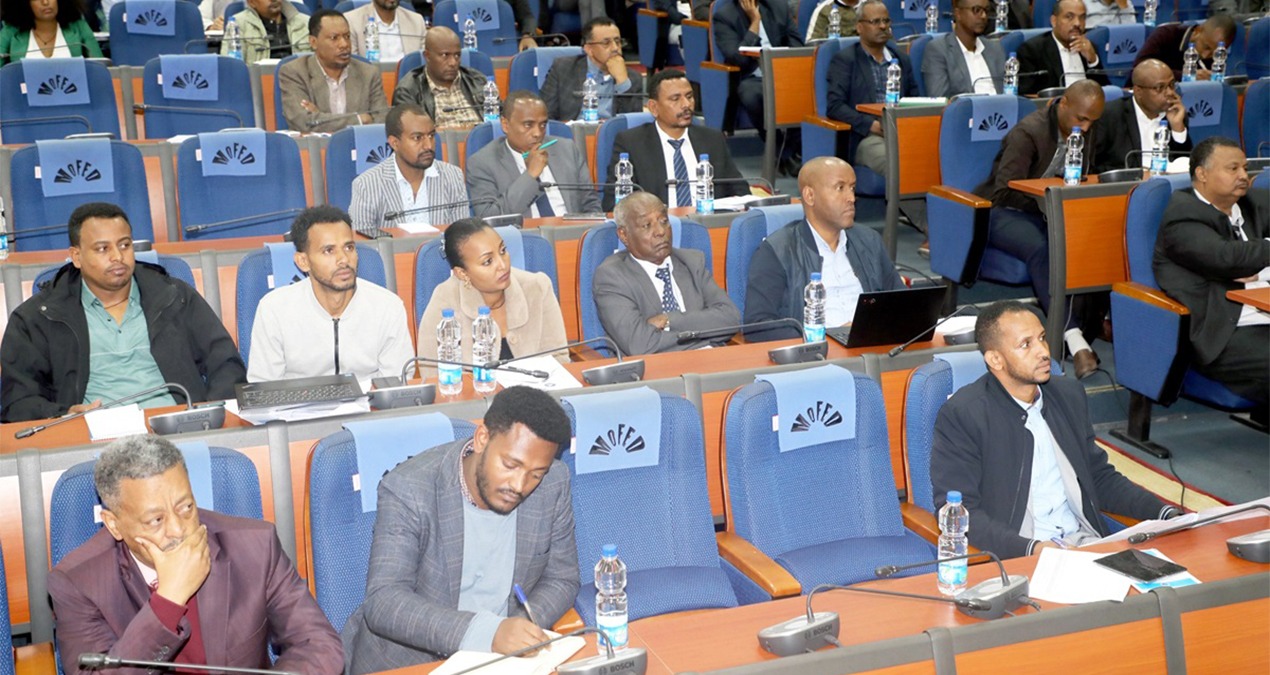
Finance Ministry consults business community on draft VAT regulation
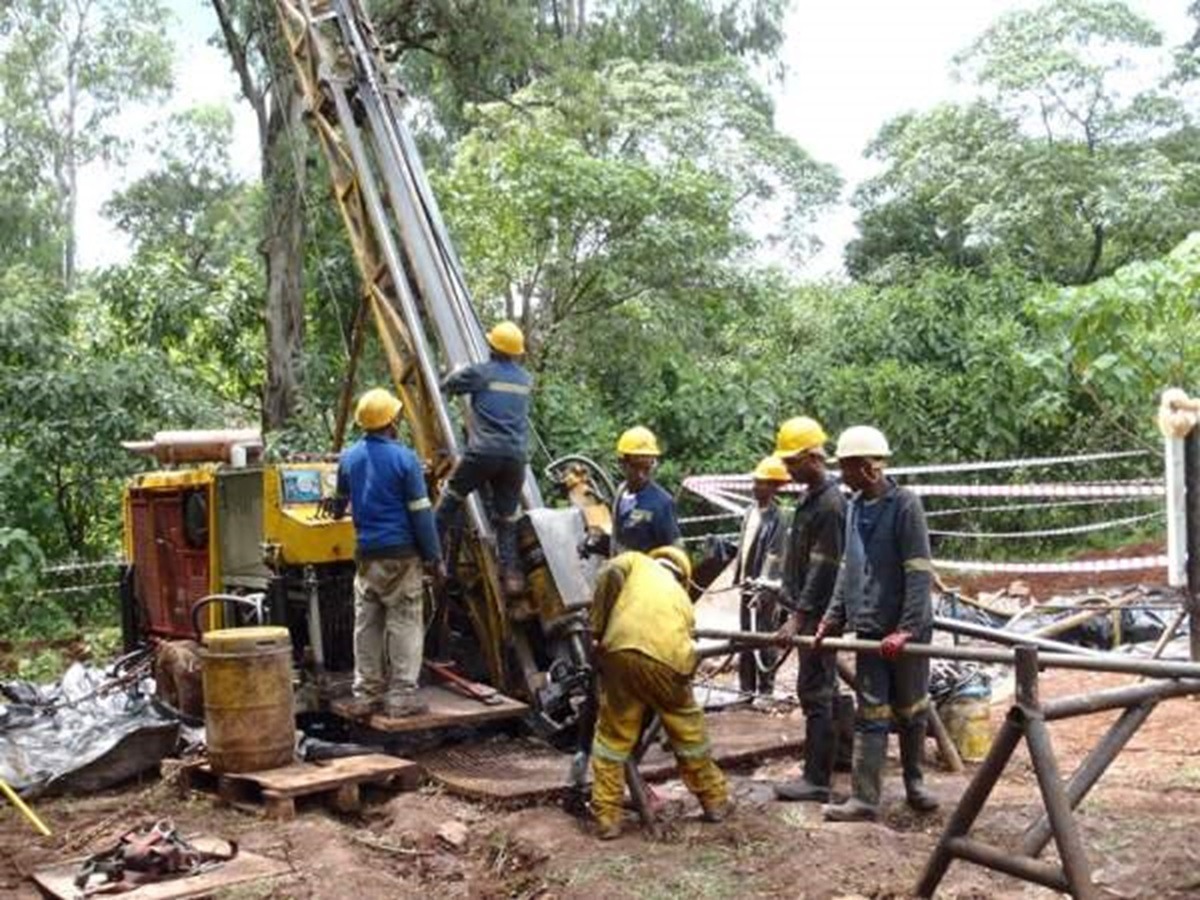
Kefi Gold & Copper announces key infrastructure progress at its Tulu Kapi gold project in Ethiopia

Travel & Tourism - Ethiopia
- In Ethiopia, the Travel & Tourism market is expected to generate a revenue of US$2,256.00m by 2024, with a projected annual growth rate of 6.42% from 2024 to 2029, leading to a market volume of US$3,079.00m by 2029.
- The Hotels market is anticipated to be the largest market, with a projected market volume of US$993.90m in 2024.
- The number of users in this market is expected to reach 29,400.00k users by 2029, with a user penetration of 17.4% in 2024, which is expected to increase to 30.2% by 2029.
- The average revenue per user (ARPU) is projected to be US$99.89.
- It is expected that 73% of the total revenue in the Travel & Tourism market will be generated through online sales by 2029.
- When compared globally, United States is projected to generate the highest revenue of US$214bn in 2024.
- Ethiopia's travel and tourism industry is on the rise, with a focus on ecotourism and cultural experiences.
Key regions: Malaysia , Europe , Singapore , Vietnam , United States
Definition:
The Travel & Tourism market encompasses a diverse range of accommodation services catering to the needs and preferences of travelers. This dynamic market includes package holidays, hotel accommodations, private vacation rentals, camping experiences, and cruises.
The market consists of five further markets.
- The Cruises market covers multi-day vacation trips on a cruise ship. The Cruises market encompasses exclusively passenger ticket revenues.
- The Vacation Rentals market comprises of private accommodation bookings which includes private holiday homes and houses as well as short-term rental of private rooms or flats.
- The Hotels market includes stays in hotels and professionally run guest houses.
- The Package Holidays market comprises of travel deals that normally contain travel and accommodation sold for one price, although optional further provisions can be included such as catering and tourist services.
- The Camping market includes bookings at camping sites for pitches using tents, campervans, or trailers. These can be associated with big chains or privately managed campsites.
Additional Information:
The main performance indicators of the Travel & Tourism market are revenues, average revenue per user (ARPU), users and user penetration rates. Additionally, online and offline sales channel shares display the distribution of online and offline bookings. The ARPU refers to the average revenue one user generates per year while the revenue represents the total booking volume. Revenues are generated through both online and offline sales channels and include exclusively B2C revenues and users for the above-mentioned markets. Users represent the aggregated number of guests. Each user is only counted once per year. Additional definitions for each market can be found within the respective market pages.
The booking volume includes all booked travels made by users from the selected region, independent of the departure and arrival. The scope includes domestic and outbound travel.
Prominent players in this sector include online travel agencies (OTAs) like Expedia and Opodo, as well as tour operators such as TUI. Specialized platforms like Hotels.com, Booking.com, and Airbnb facilitate the online booking of hotels and private accommodations, contributing significantly to the market's vibrancy.
For further information on the data displayed, refer to the info button right next to each box.
- Bookings directly via the website of the service provider, travel agencies, online travel agencies (OTAs) or telephone
out-of-scope
- Business trips
- Other forms of trips (e.g. excursions, etc.)
Travel & Tourism
- Vacation Rentals
- Package Holidays
- Analyst Opinion
Ethiopia's Travel & Tourism market is experiencing significant growth and development, driven by various factors shaping the industry within the country. Customer preferences: Travelers in Ethiopia are increasingly seeking authentic cultural experiences, eco-friendly tourism options, and off-the-beaten-path destinations. This shift in preferences is influenced by a global trend towards sustainable and responsible tourism practices. Trends in the market: One notable trend in Ethiopia's Travel & Tourism market is the rising popularity of adventure tourism, with activities such as hiking in the Simien Mountains and visiting the ancient rock-hewn churches of Lalibela attracting more visitors. Additionally, the country's diverse wildlife and national parks are becoming key attractions for nature enthusiasts and wildlife lovers. Local special circumstances: Ethiopia's rich cultural heritage, including its UNESCO World Heritage sites and vibrant traditional festivals, sets it apart as a unique travel destination. The country's unique cuisine, coffee culture, and traditional music also contribute to its appeal among tourists looking for authentic experiences. Underlying macroeconomic factors: The Ethiopian government's focus on infrastructure development, including improvements in transportation networks and accommodation facilities, has played a significant role in driving the growth of the Travel & Tourism sector. Additionally, initiatives to promote the country's tourism offerings internationally and simplify visa procedures have helped attract more visitors to Ethiopia.
- Methodology
Data coverage:
Modeling approach:
Additional notes:
- Sales Channels
- Travel Behavior
- Global Comparison
- Key Market Indicators
Mon - Fri, 9am - 6pm (EST)
Mon - Fri, 9am - 5pm (SGT)
Mon - Fri, 10:00am - 6:00pm (JST)
Mon - Fri, 9:30am - 5pm (GMT)
- Get immediate access to all Market Insights, reports & statistics
- Download data in multiple formats for collaborative research
- Includes usage & publication rights for sharing data externally

Tourism in Ethiopia
Development of the tourism sector in ethiopia from 1995 to 2021.

Revenues from tourism

All data for Ethiopia in detail


Scaling up pathways to growth in Ethiopia through tourism investments
Qursum qasim.

From the otherworldly vistas of the Bale Mountains to the rock-hewn churches of Lalibela and the mysterious stelae of Tiya, Ethiopia is home to a unique mix of natural, cultural, and historical sites. UNESCO has added 11 Ethiopian sites to its World Heritage List with an additional seven on the tentative list. Ethiopian food has found a global audience (culinary tourism is an $11 billion market globally!) and Ethiopian Airlines brings the world to Ethiopia’s front door.
Ethiopia saw a near doubling of tourist arrivals from 438,000 in 2010 to 936,000 in 2017. This was driven by improvements in air travel connectivity and a dedicated effort to market Ethiopia as a world-class destination. It led to an increase in foreign exchange earnings which reached a high of nearly $3.6 billion in 2018, at more than 45% of exports. In 2019, an estimated 1.9 million jobs were in the tourism sector which generated more than 6% of GDP.
As seen elsewhere across the globe, tourism took a nosedive in Ethiopia during the COVID-19 pandemic. Though other destinations are now recovering, tourism in Ethiopia continues to struggle as the country grapples with fragility and macroeconomic challenges. A bump in tourists was seen in the aftermath of the 2022 peace accord but tourism receipts fell by more than 6% in 2023 compared to 2022 (UNWTO Barometer).
Research shows that conflict lowers annual GDP growth by 2-8.4% (Pathways to Peace, United Nations & World Bank, 2018). Some estimates place the cost of the conflict in Ethiopia at $6 billion in productivity losses, which have far-reaching effects. The scale of the losses makes investment in economic diversification and regeneration even more urgent. Even as the 2022 peace deal led to a minor resurgence in tourism revenues, increasing fragility in other regions and continued food insecurity in Tigray threatens prospects of economic growth.
In this context, the question arises, why should we focus on tourism investments?
For one, tourism in Ethiopia offers a strong opportunity to create new jobs, support domestic resource mobilization, and contribute to the country’s foreign exchange earnings . Tourism also creates demand for other industries, including food processing, retail, construction, logistics, renewable energy, and transport, generating direct and indirect economic benefits. Tourism employs skilled and unskilled labor with low probability for automation, as tourists continue to value positive customer service experiences. Green tourism offers the additional benefits of conserving and protecting natural and cultural assets, and incentivizing greater community participation in conservation as people see the benefits of preserving assets.
Second, Ethiopia has the assets and endowments needed to be a vibrant and popular destination for tourists across multiple segments . Adventure tourism to Erta Ale, food tours in Addis, pilgrimages to ‘New Jerusalem’ in Lalibela, there is something for everyone! The diversity of experiences across the country speak to its potential for repeat visitors and higher spending per tourist.
Thirdly, Ethiopia is a large market and well connected to the rest of the world via Addis Ababa and Ethiopian Airlines. With ease of access to the destination generally being a major factor in tourist decision-making, Ethiopia is well-placed. Connectivity (and, indeed, security) within the country remains challenging but this can be addressed through investments in infrastructure and a broader effort to improve security. Investments targeted strategically in regions and locations where there is an existing tourism industry, baseline infrastructure, and critical mass of tourism businesses can help draw more tourists, provided the security situation improves.
There is no denying that the binding constraint for tourism development currently is the inaccessibility of some key sites and the safety concerns across several regions. Tourism businesses report having to turn away tourists and proposed group excursions due to the uncertain security situation and inability to offer adequate safety to visitors. There is also concern about the lack of coordination between government initiatives to support the industry and private sector stakeholders. Both sets of stakeholders need to be better aligned to mobilize new investments and develop a menu of activities and experiences that would attract tourists. This is not a short-term agenda and will take consistent efforts to bear fruit.
The World Bank is working with the Ethiopia Ministry of Culture and Tourism to pilot the mapping of key tourism assets (i.e. attractions, cultural and historical sites that would draw tourists and generate revenues), in order to support integrated destination management in one region of the country. Integrated destination management is a holistic approach that identifies the combination of infrastructure investments, firm-level support and capacity building, and private capital mobilization that would be needed to leverage Ethiopia’s tourism assets more fully for inclusive, green growth.
While Ethiopia faces compounded challenges of fragility, macroeconomic instability, and spiraling food insecurity, it is essential to scale up investments that lay the ground for medium-to-long-term growth and employment. One of the main factors for the relapse of post-conflict countries into conflict is the lack of economic opportunities, which can exacerbate existing fault lines. Tourism offers an opportunity for diversified economic growth, and robust investments now would lay the foundation for future growth .
Get updates from Nasikiliza
Thank you for choosing to be part of the Nasikiliza community!
Your subscription is now active. The latest blog posts and blog-related announcements will be delivered directly to your email inbox. You may unsubscribe at any time.

Senior Private Sector Specialist
Join the Conversation
- Share on mail
- comments added
Ethiopia records biggest growth in World Travel and Tourism
Ethiopia’s Travel and Tourism economy grew by 48.6% in 2018 – the largest of any country in the world – according to the World Travel and Tourism Council’s (WTTC) annual review of the economic impact and social importance of the sector.
In 2018, Travel and Tourism contributed $7.4 billion to the country’s economy, an increase of $2.2 billion on 2017. The sector now represents 9.4% of Ethiopia’s total economy.
The Council’s research compares the Travel and Tourism sectors across 185 countries and shows that in 2018 in Ethiopia the sectors:
- Significantly outpaced the global growth rate of 3.9%, the African growth rate of 5.6%
- Supported 2.2 million jobs, or 8.3% total employment
- Was primarily driven by leisure travellers: 79% of the spending was generated by leisure visitors and 21% from business travellers
- Is strongly weighted towards international travel: 77% of spending came from international travellers and 23% from domestic
Commenting on the numbers, Gloria Guevara, WTTC President and CEO said:
“Ethiopia’s Travel and Tourism boom was one of the great success stories of 2018. This has been driven by the very strong performance of aviation in the country and the development of Addis Ababa as a dynamic and growing regional hub.”
“Travel and Tourism in Ethiopia now accounts for one in every $11 in the entire economy and one in 12 of all jobs. I would like to acknowledge the country’s commitment to the power of Travel and Tourism to drive economic growth, job creation and social enhancement.”
Latest News
Lessons From Ethiopia’s Post-War Tourism Recovery

Dawit Habtemariam , Skift
January 27th, 2023 at 11:10 AM EST
The civil war is over, but Western government travel warnings are still there. If there's going to be a recovery, tourism authorities need to focus their energy on getting those lifted. That's going to require repeated messaging that the war is over.
Dawit Habtemariam
Ethiopia’s tourism sector has been hit hard in the last two years by Covid and a brutal civil war, with spending down by more than $2 billion. The tourist sites and infrastructure have been spared, but the sector doesn’t have the confidence of governments, travelers and tour group operators that the conflict is over and the country is a safe destination.
For two years, Ethiopia has had an ethnic civil war largely fought between the Tigray People’s Liberation Front (TPLF) and the governments of Ethiopia and Eritrea. It started in November 2020 when the Ethiopian government sent troops into the northern Tigray region after prime minister Abiy Ahmed accused the TPLF of attacking a military base. The war was mostly concentrated in Tigray but did spill into parts of other regions like Amhara.
The conflict may have led to over 600,000 lives lost, according to the Financial Times . Millions of people have been displaced . The U.N. High Commissioner for Human Rights have accused Tigrayan forces of committing war crimes and “human rights abuses” and the Ethiopian government of committing “crimes against humanity.“
In November, the Tigrayan rebels and the Ethiopian government signed a peace deal to end hostilities.
Before the horrific war and the pandemic, the country drew over 800,000 tourists and spending amounted to $3.5 billion in 2019, according to the World Bank . A growing segment of tourists have been from the U.S., UK and Europe, according to Intrepid Travel East African General Manager Samuel Karani.
Popularity was rising so much that some of the country’s beautiful natural parks, churches, mountains and historic sites experienced overtourism. Visitation to the Gheralta mountains, for example, was becoming popular to the point that some of the historic churches experienced overcrowding, according to Mark Chapman, founder of Tesfa Tours , which has operated in Ethiopia since 2010.
In 2020, visitation dropped to 500,000 and spending fell by 35 percent to $2.28 billion, according to the World Bank. In the last two years, the country lost $2 billion thanks to the war and Covid, Ethiopia Tourism State Minister Sileshi Girma told Voice of America .
“A lot of tour operators stopped operating because nobody was earning any money,” said Chapman. “It was hard to survive these few years and keep paying overhead.”
The war prolonged any hopes of the return of tour groups since Covid. In March 2022, Intrepid Travel decided to hold off on offering tours even though traveler interest had resumed. Their tourist destinations and routes they used were “unready” and the war hadn’t settled down, said Karani.
Tourist sites and attractions are typically not spared in conflicts. The historic architecture of Aleppo suffered massive destruction during the Syrian Civil War.
Fortunately for Ethiopia, popular tourist sites like Lalibela that were caught in the conflict have been spared. Lalibela, a holy site in Ethiopian Orthodox Christianity, is home to 900 year old rock-hewn churches. The churches attract over 80,000 visitors per year and are a UNESCO World Heritage site .
Lalibela was occupied by Tigrayan rebels from early August to mid-December 2021. The government lost control again for a few days in December then regained it . The physical damage to the town’s large tourist infrastructure left behind hasn’t been long lasting. “The churches haven’t been damaged, thank God, and 90 percent of hotels were pretty much okay, “ said Chapman. On January 7, the town hosted thousands of visitors for the festival of Genna, which is also known as Ethiopian Christmas. Ethiopia Tourism State Minister Sileshi Girma brought ambassadors from several countries to the festival.
@rrymmee Lalibela is next level and u should go there ! #lalibela #eastaftica #ethiopia #travelethiopia ♬ Lalibela – Gossaye Tesfaye
Individual travelers are returning, but there are still virtually no tour groups, said Chapman. “It’s tour groups that are the big business for most tour operators and hotels,” he said. He expects some to start returning before the end of the year.
Intrepid will have its first post-Covid trip to Ethiopia in September this year and the itinerary will include the Tigray region, according to Karani. It will offer the same activities it had in 2019, one of which will be visiting the historic city of Axum, located in Tigray.
At the moment, Western governments continue to discourage travel to the country. The U.S. State Travel Advisory warns American citizens to reconsider travel to Ethiopia and to not travel to the Tigray and Amhara regions. The UK warns its citizens to stay away from Tigray.
The warnings introduce traveler insurance coverage issues, which deters traveler and group trips, according to Karani and Chapman. Major tourist attractions become unavailable for visits. “The British government travel advice says don’t go within 30 kilometers of the border of Tigray and that rules out parts of the [Simien] national park,” said Chapman.
Intrepid Travel and their partners are hopeful the second half of the year will see normalcy, but they are watching how the peace deal plays out. “Five months before September we will be reviewing the situation again,” Karani said.
The Daily Newsletter
Our daily coverage of the global travel industry. Written by editors and analysts from across Skift’s brands.
Have a confidential tip for Skift? Get in touch
Tags: africa , coronavirus recovery , Covid , ethiopia , safety
Photo credit: Lalibela is one of Ethiopia's most popular destinations. The town was briefly occupied by Tigrayan rebels. Mulugeta Wolde / Unsplash
- Ethio-China St, KT 12 Building, 6th Floor, Suite 601, P.O.Box 2255, Addis Ababa, Ethiopia


DISCOVERING ETHIOPIA | An in depth look at the tourism landscape
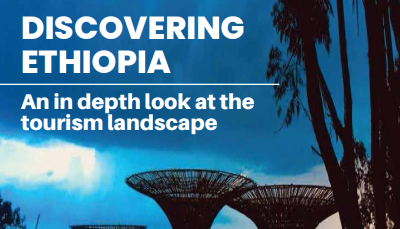
“ The only man I envy is the man who has not yet been to Africa – for he has so much to look forward to Richard Mullin“ The only man I envy is the man who has not yet been to Africa – for he has so much to look forward to Richard Mullin
“The prospect of visiting Ethiopia attracted me more strongly than a trip to France, England, and America combined.” Nelson Mandela
Following the pandemic-induced slowdown, Ethiopia has experienced a significant rebound in tourist arrivals and receipts, highlighting a revival and growing interest in the country’s tourism sector.
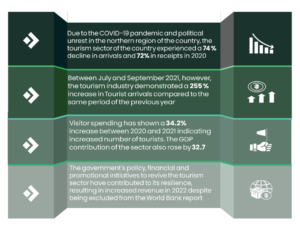
Ethiopia, in general, and the city of Addis Ababa, in particular, have been operation centres for more than 13 international hotel chains such as Hilton Addis, Marriot Executive Apartments, Sheraton Addis, Ramada Addis, Radisson Blu and Hyatt Regency to name a few.
According to the latest study by W Hospitality Group, Ethiopia is ranked 4th in terms of new hotel development, with 29 chain hotels and 5,206 rooms in the pipeline. Radisson Blu Hotel, Marriott International, Accor and Hilton are among the major brands expected to increase their presence in the country. Ethiopia has been in the top five countries on the list for the past six years.
As a result of the various upcoming star-designated hotels and speciality restaurants, the country’s capital, Addis Ababa, maintained the top three ranking for cities with large numbers of hotels and rooms planned in Africa for three consecutive years, following renowned tourist cities like Cairo.
Besides Addis Ababa, cities such as Dire Dawa, Bishoftu, Hawassa, Bahir Dar, Arba Minch, Gondar, and Adama have also seen remarkable hotel investment projects. These investments encompass luxurious hotels and resorts extending their services and footprint throughout the country. Notable mentions include Haile Resorts and Kuriftu Hotel and Spa.
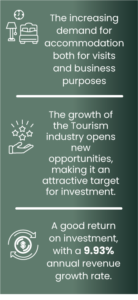
Investors should consider targeting the Ethiopian tourism market due to the growth in various segments
- Tour Operations
Tourist guides, travel agents, and tour operators offer promising opportunities. For instance, the booking market is expected to grow significantly. Targeting stopover tourists and business (MICE) tourists can lead to business growth. Providing integrated travel packages and creating a well-rounded experience can enhance revenue per passenger and attract more visitors.
- Vacation Rentals
Accommodation-sharing platforms such as Airbnb and Vrbo have disrupted the traditional hotel industry. The global vacation rental market is projected to reach USD 107.70 billion by 2027.
In Ethiopia, the vacation rental segment is expected to generate USD 334.70 million revenue in 2023, growing at an annual rate of 5.47%. There is a demand for localized and coordinated experiences, creating opportunities for specialized shared accommodation platforms.
Ethiopia’s campsites segment, especially in the southern region, offers investment opportunities in camping, lodges, and resorts. The camping sector is expected to generate USD 5.24 million revenue in 2023, growing at an annual rate of 46.85%.
The Simien Mountains National Park, Bale Mountains National Park, and Mount Yossef are already positioned as world-class destinations for high-altitude trekking, but there is a need to enhance tourism facilities and services, including expanded and upgraded camping sites.
- Tourism Tech Startups
Investing in Tourism tech startups can bring positive outcomes, as technology plays a vital role in ensuring a secure and smooth travel experience. Initiatives like 1888EC are actively developing digital solutions and fostering job creation within Ethiopia’s tourism industry.
Promising markets for Tourism tech startups encompass alternative housing, hotel and hospitality management, artificial intelligence, tours and activities, as well as diverse mobility sectors.
The MICE market (Meetings, Incentives, Conferences/Congresses, Events/Exhibitions) has become an increasingly important segment of the Tourism industry. Third, only to Brussels and Washington DC, Addis Ababa is home to 118 diplomatic missions accredited by the government of Ethiopia, the AU and the UNECA. As a result, the country hosts multiple international meetings and conferences every year.
The 2022 Annual Research Key Highlights from the World Travel and Tourism Council (WTTC) indicate that there has been an increase in business spending in Ethiopia during 2021 compared to 2019. This rise suggests a growing demand for services from business travellers and highlights the sector’s expanding contribution to the country and the country’s potential not only as a leisure but also as a business destination.
Forecasts for the Ethiopian Tourism sector are optimistic about its future development. All tourism segments are displaying encouraging growth rates, with camping leading the way at a remarkable 46.85% increase, reflecting the anticipated interest of tourists in Ecotourism and adventure experiences through camping.
With its abundance of national parks, wildlife reserves, and mountainous terrain, Ethiopia possesses immense potential in the Tourism industry that remains untapped.
- Strategic geographic location in East Africa
A gateway to the region with easy access to neighbouring countries and a key transportation and logistics hub connecting Africa, Asia, and Europe
- Multiple UNESCO registered heritage sites
The country is home to 9 UNESCO World Heritage Sites, ranked 2nd in Africa.
- Addis Ababa, a significant diplomatic and political hub
Home to AU, ECA, and 115 foreign missions, making it the third-highest globally in terms of diplomatic presence.
- Ethiopian Airlines: Africa’s top carrier
Serving 131 international passenger and cargo destinations, including 63 African cities, flying to more destinations in the continent more than any other airline.
- Market ready product offers including meeting venues and hotels
More than 600 hotels with more than 13 chain hotels and more in the pipeline. World-class large conference venues at the AU, UNECA, and AAICEC
- Secure country with World Trade and Tourism Council (WTTC) Safety and Security stamp (2021)
In 2021 the country has received WTTC’s Safety and Security stamp, indicating that the country follows global standards to ensure the well-being of tourists and visitors.
- Tourism is one of the priority sectors that the Ethiopian government granted tax exemption & incentives
Specific details of the tax exemptions and incentives can be seen in the next section
- One stop shop service delivery for investors by the Ethiopian Investmen Commission
EIC facilitates investment procedures, offers guidance, and assists investors in navigating the business landscape in Ethiopia.
- Simple E-visa application and nearly 40 visa on arrival eligible countries
- Continuing efforts to digitalize the travel & hospitality industries to increase convenience & competitiveness
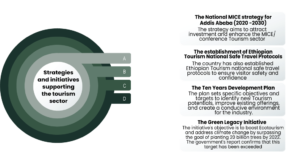
Related Posts

China Wants to ‘Go Global,’ Ethiopia Must Use the Opportunity

Ethiopia’s AGOA-EXIT: looking beyond the headlines
Leave a comment cancel reply.
Your email address will not be published. Required fields are marked *
Save my name, email, and website in this browser for the next time I comment.

ACE brings a strategic cross-domain perspective with deep expertise in driving public-sector delivery capabilities and private-sector development by partnering with government, private-sector, and development partners.
- +251-962-001-111
- [email protected]

Welcome to Ethiopia, Land of Origins
Ethiopia invites you to discover why it is the origin of so much! As you explore Ethiopia, you will be put in touch with your own origins…for this is a Land of Origins
Things to do in Ethiopia

Cultural Experiences – Culturally ebullient but not well discovered, every unforgettable undertaking you do in Ethiopia could be labeled as a cultural experience.
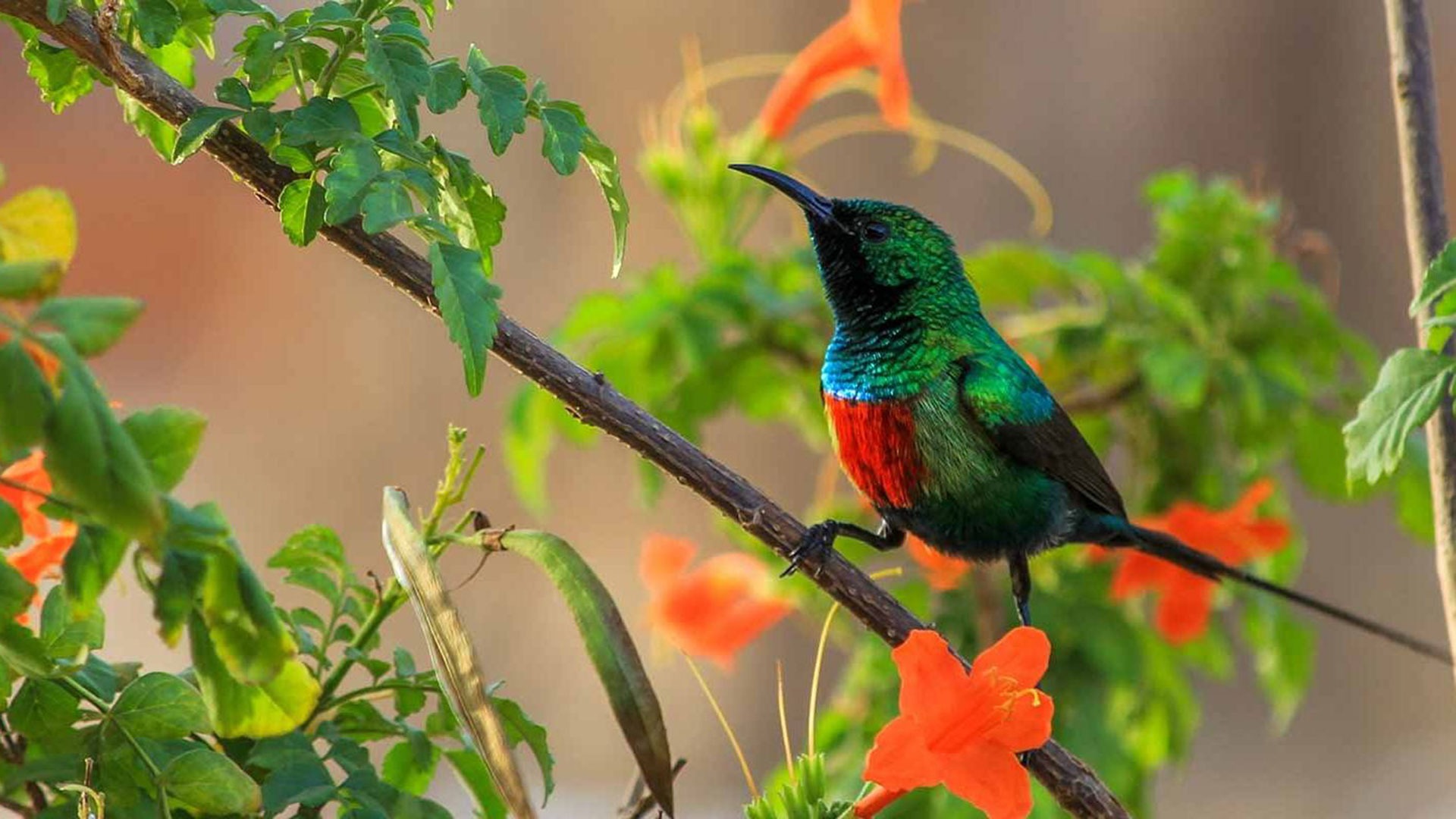
Nature Experiences – with its diverse ecological systems laden with a plethora of wildlife Ethiopia is a haven for nature travelers
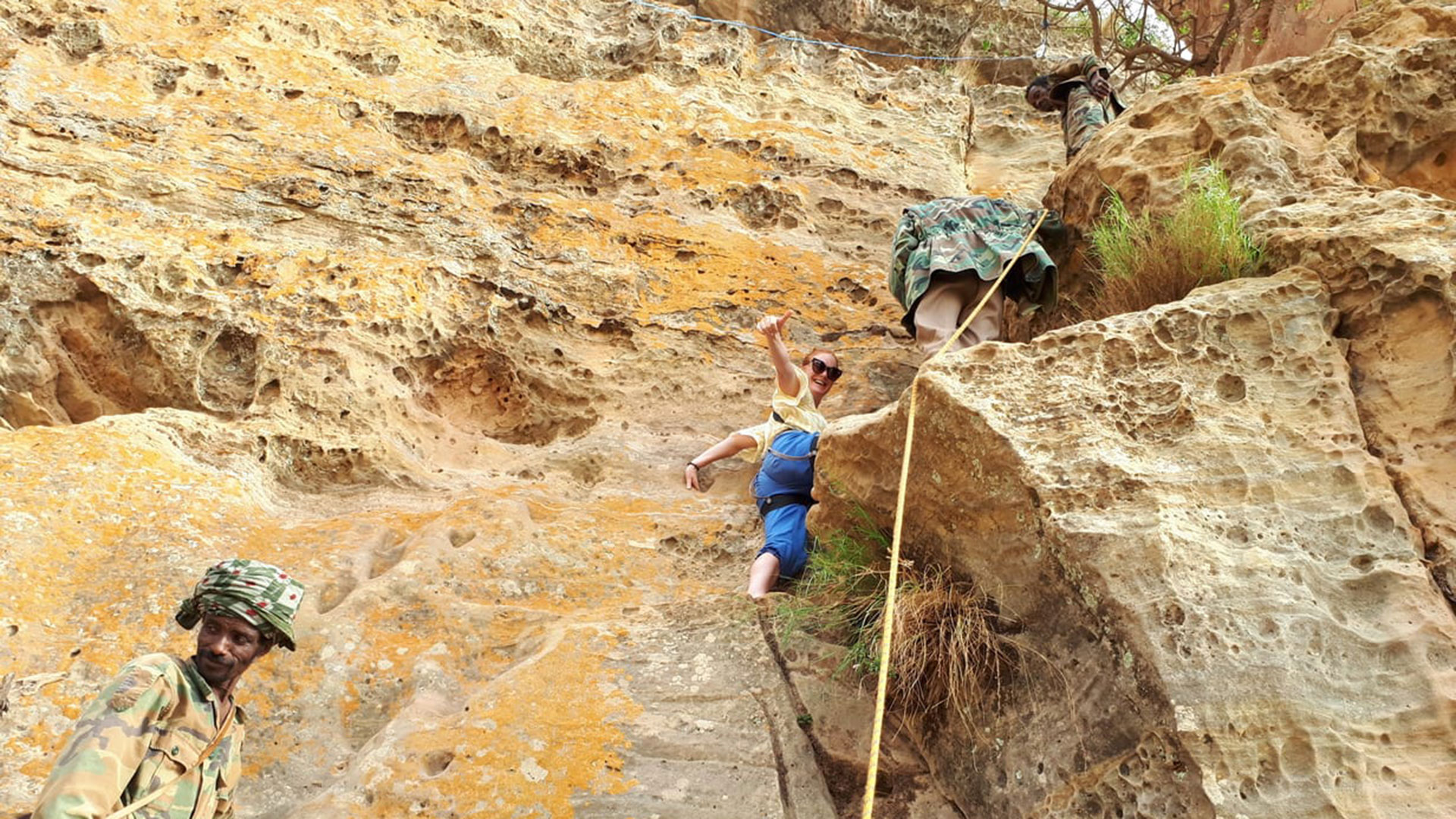
Outdoor and adventure – Outdoor and adventure are the eliciting factors that whet the appetite of all travelers to Ethiopia.
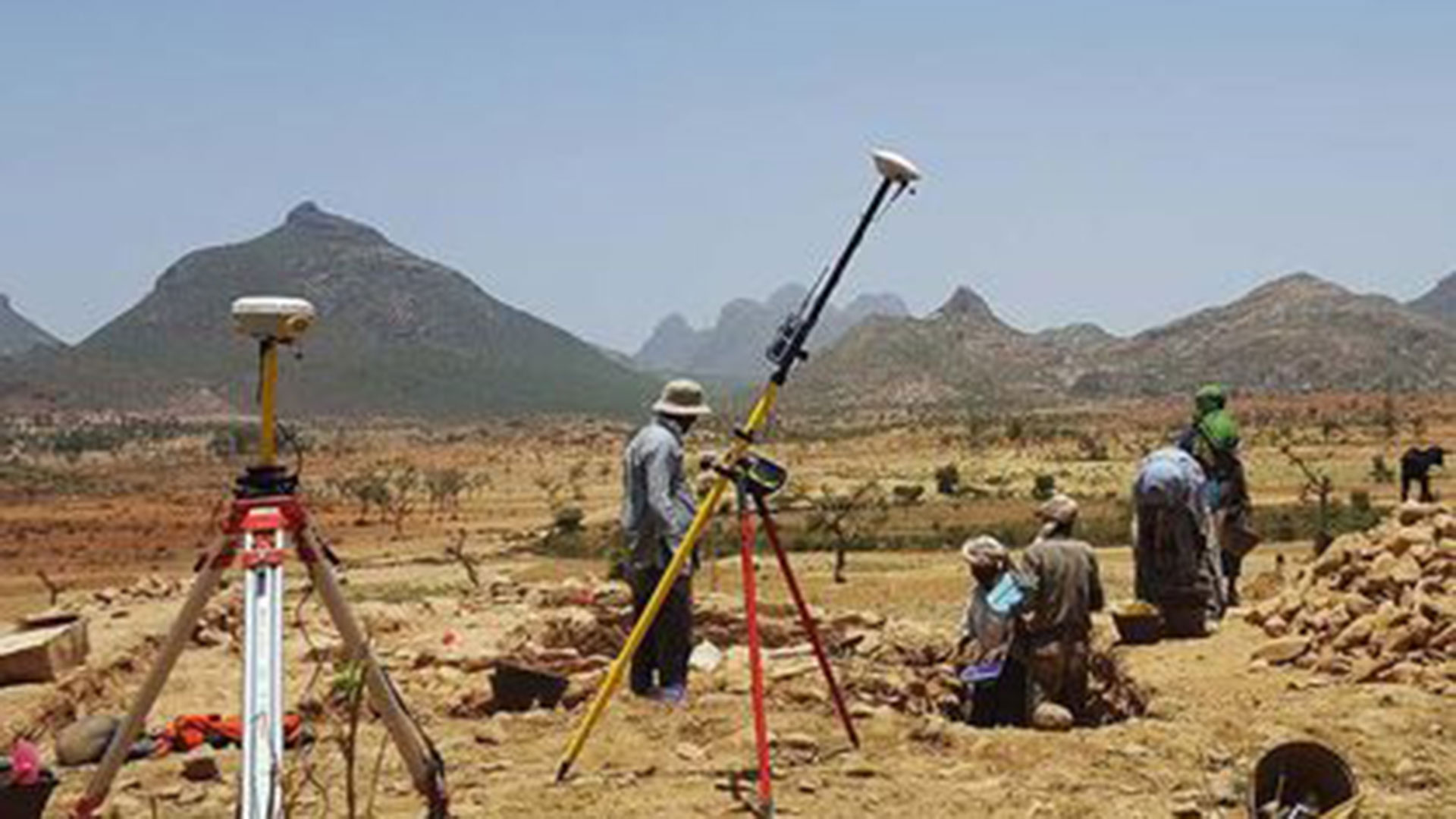
Educational Tour – Immerse yourself in the rich paleontological sites, vibrant way of life, and opulent geological resources of Ethiopia.
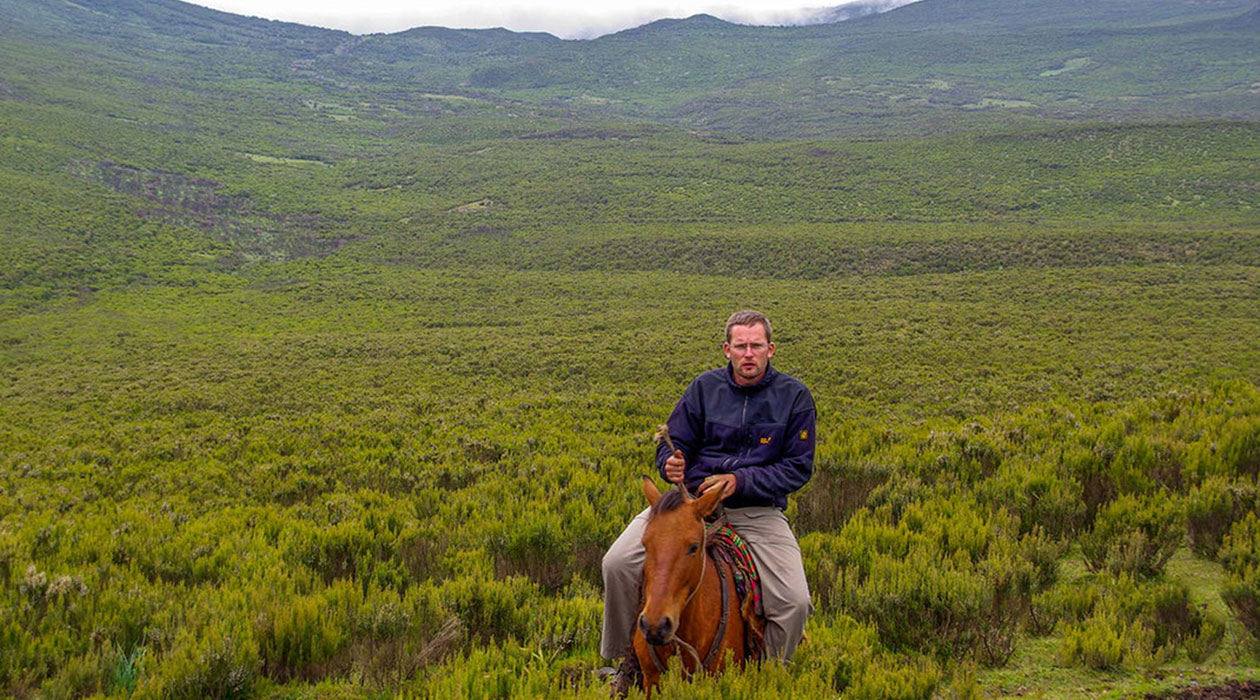
Trekking on the peaks of Ethiopia
The majestic highlands of Ethiopia offer some exceptional trekking experiences. The Simien Mountains and Bale Mountains are common favorites, and the Community Trekking trails set up in the Northern part of Ethiopia offer world-class treks while supporting local communities.
The most popular attractions to visit in your lifetime
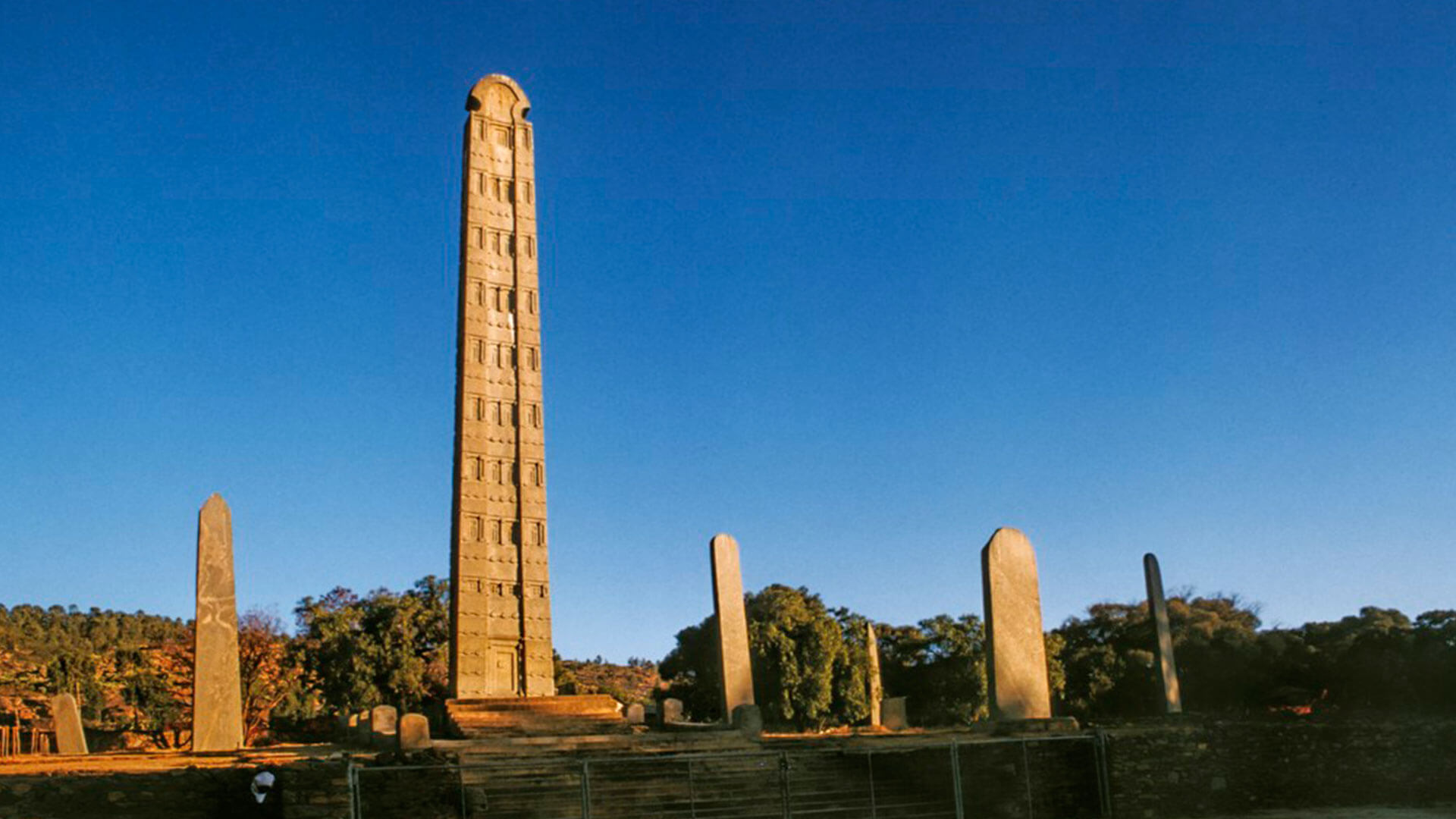
Aksum – Land of Queen Sheba
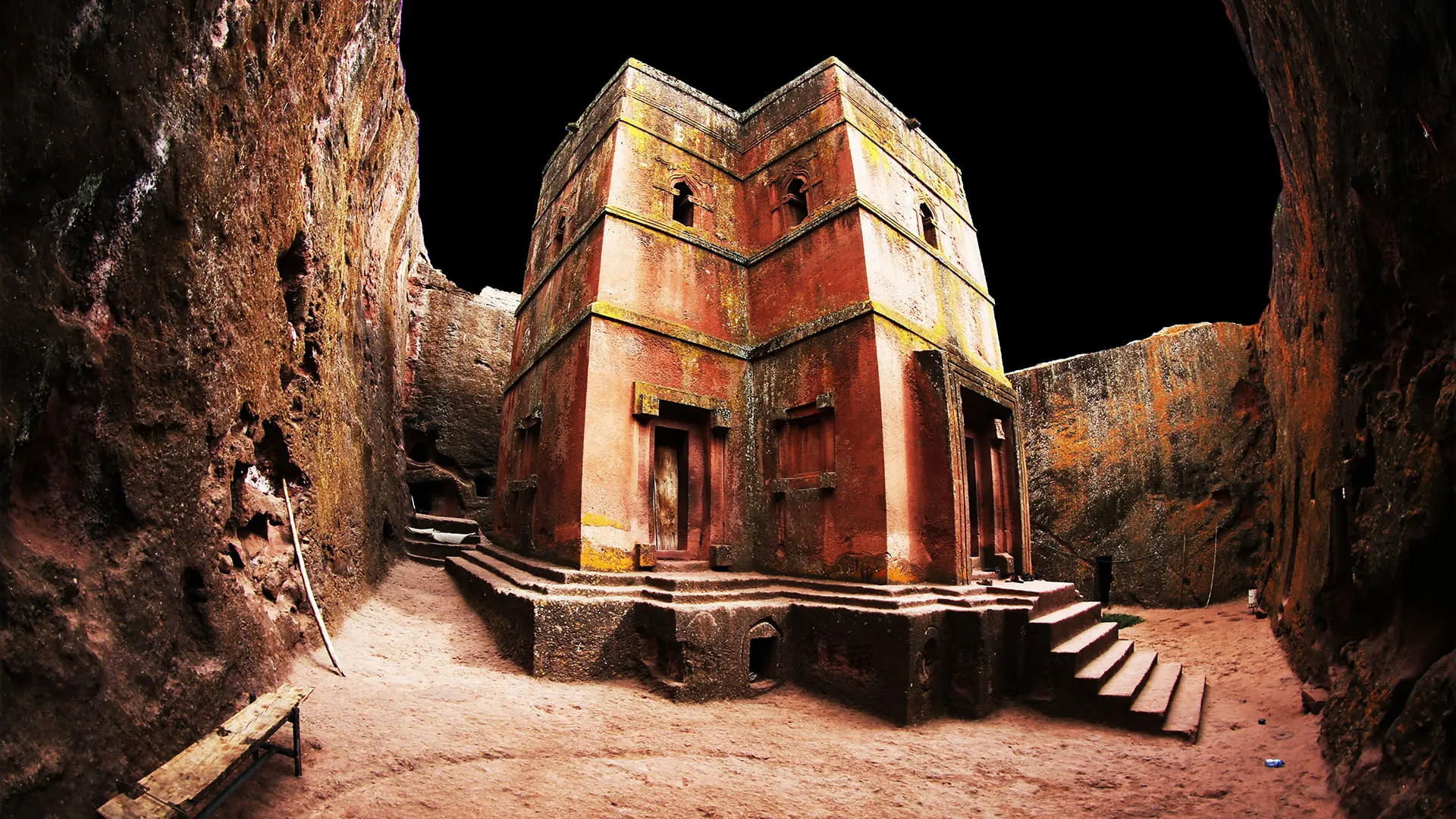
The rock hewen churches of Lalibela

Gondar – Camelot of Africa
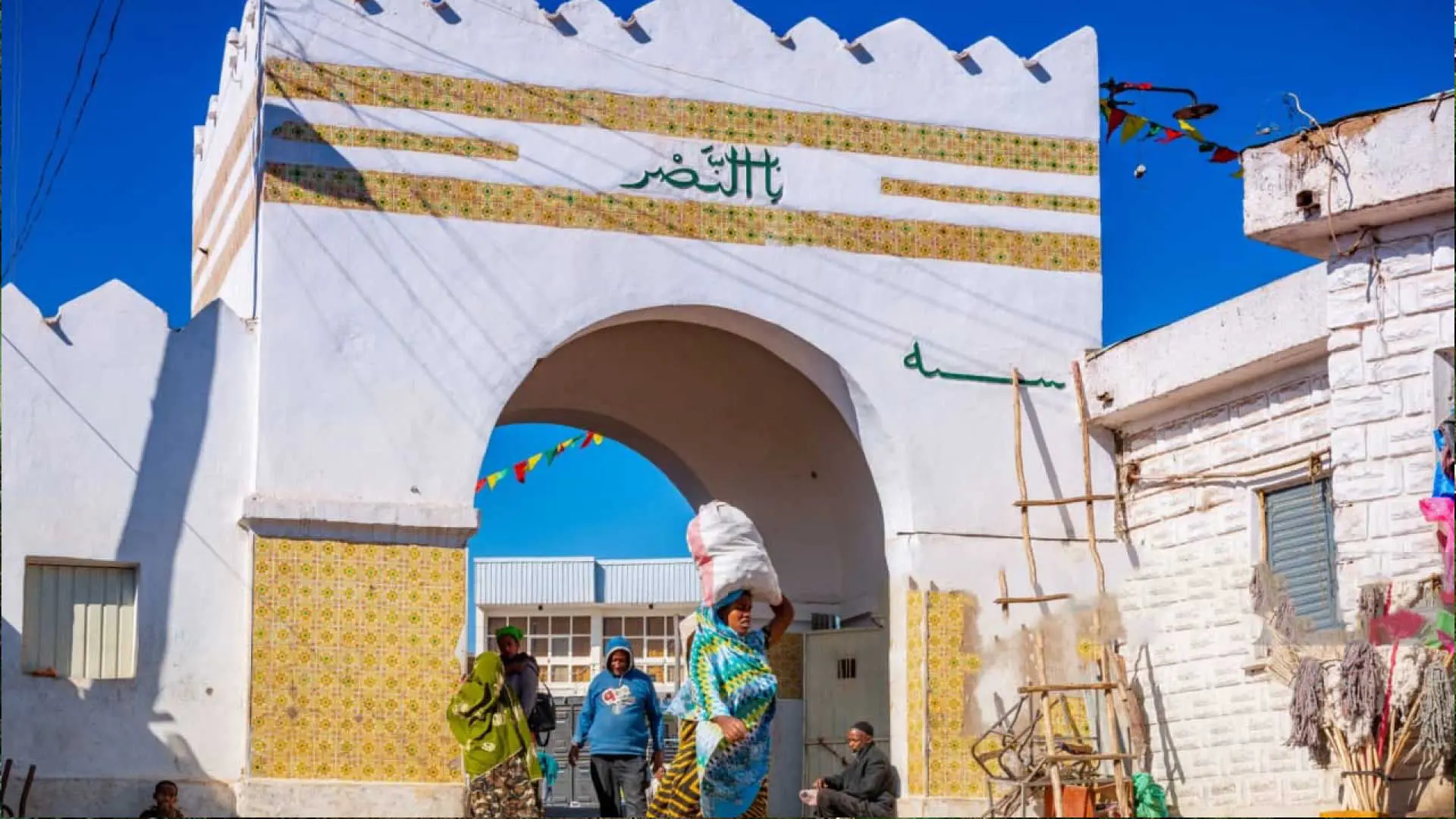
Harar – The old walled city
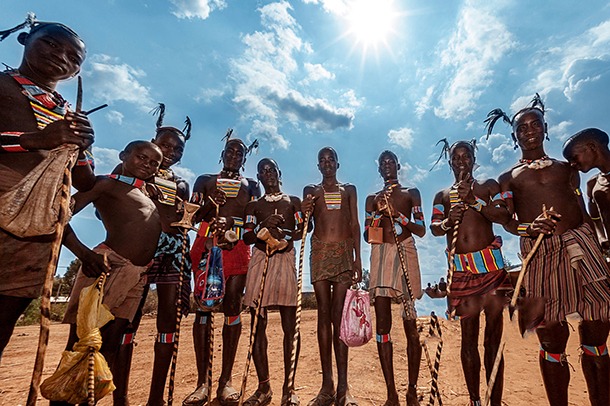
Renowned the world over for its decorated tribes, the Omo Valley is a stop on many a tourist route in Ethiopia.
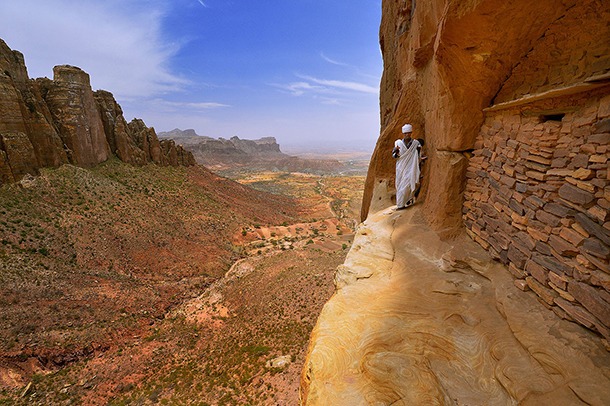
Gheralta Mountains – The luminous light bathes scattered sharp peaks that rise into the sky out of a sandy, rolling semi-desert.
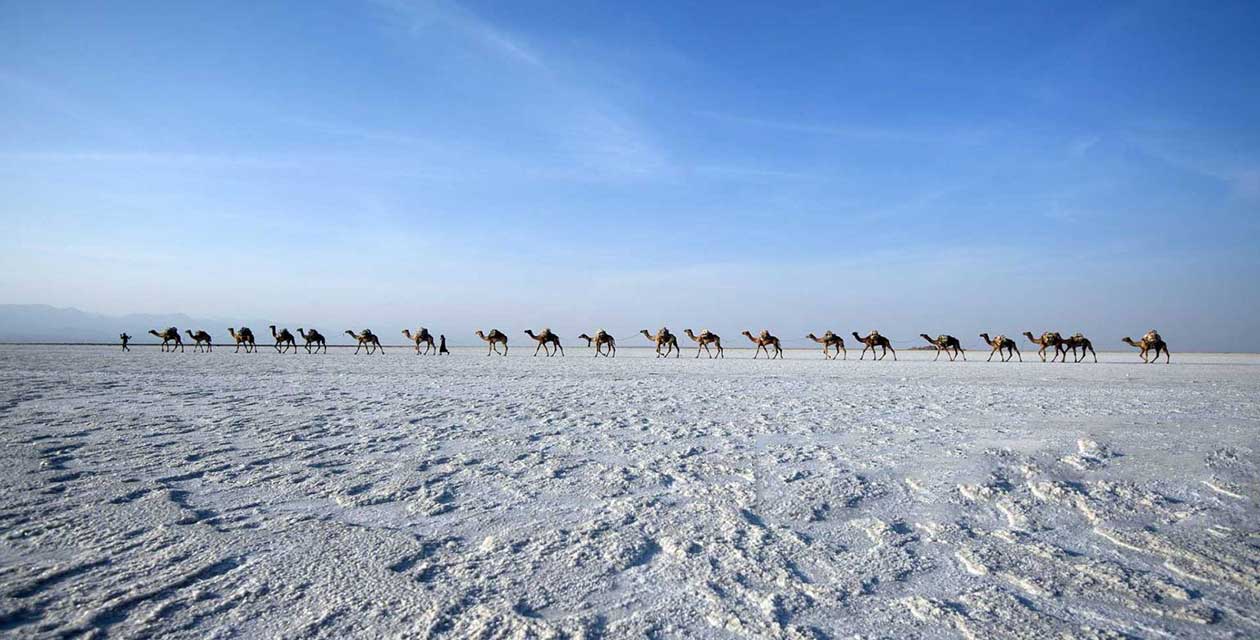
Salt caravans of the Danakil depression
Embarque em uma jornada emocionante e descubra prêmios incríveis no Cassino Jogo Fortune Tiger. A sorte está ao seu alcance em jogofortunetiger.com.br !
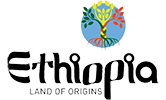
- [email protected]
- +251 11 861 96 18
- Africa Avenue, Japan Embassy Traffic Light, Addis Ababa, Ethiopia
About Ethiopia
- Ethiopia Today
- Fauna and Flora
Important Links
- Apply for Ethiopian E-visa
- Ethiopian Convention Bureau
- Ethiopian Airlines
Destinations
- Addis Ababa and surroundings
- The North Historic and Simien Mountains
- The Cultural South
- The Marvel of East
- The Afar Triangle
- The coffee route
- National Parks
- World Heritage Sites
Things to do
- Culture Experiences
- Nature Experiences
- Outdoor and Adventure
- Learning and Educational Travel
Plan your trip
- Get your visa
- Book your flight
- General Practicalities
- When to Travel
- Meet your tour operators
- Health and Safety
© 2023 Ministry of Tourism – Ethiopia. All rights reserved.
- Privacy Policy
- Terms and Conditions
- Photo Credit
Academia.edu no longer supports Internet Explorer.
To browse Academia.edu and the wider internet faster and more securely, please take a few seconds to upgrade your browser .
Enter the email address you signed up with and we'll email you a reset link.
- We're Hiring!
- Help Center

Challenges and Prospectus of Ethiopian Tourism Industry TekabeSintayehuSheferahu

This study focuses on identifying the challenges and prospects of Ethiopian tourism industry.The primary data was collected from 501 foreign tourists in the study area. To do this, the researcher was used two types of probability sampling techniques such as stratified sampling and simple random sampling methods. The result of the study show that lack of promotion,lack of physical infrastructure (road, transportation system,network facility, availability of hotel accommodations especially tourist site), misperceptions the images of Ethiopia,shortage of human trained powerarechallenges of Ethiopian tourism industry. On the other side the Ethiopia is a capital city of Africa because the African union located in Ethiopia,Ethiopian airline the almost the leading airline from Africa and to be a member of a star alliance, Ethiopia now building the leading African man made dam, lastly Ethiopia is one the leading African country that registered heritage by UNISCO. All this are opportunities of the growth of Ethiopian tourism industry.
Related Papers
International Journal of Hospitality & Tourism Management
Selemon Thomas Fakana
Selemon Thomas Fakana , Alemken Berihun
Abstract: Tourism has been emerged as one of the effective tools in eradicating poverty. Ethiopia has huge tourism potentials like natural, non-natural, historical and cultural resources. Gambella Region is one of the attractive tourism destinations located at South West of Ethiopia. But, its tourism industry development is in infant stage. Nonetheless, limited study has carried out on identifying opportunities. Hence, the main objective of this study was identifying opportunities to enhance tourism industry development in the Region. To do so, key informants from three zones, five regional offices and thirteen woredas has purposively selected based on the defined criteria. Altogether, 103 key informants were interviewed besides to field observation. The collected firsthand data were edited, categorized, arranged and organized and encoded into SPSS software version 20. Qualitative data was being analyzed in meaningful content description whereas quantitative data was being analyzed in numerical values. Findings of this study revealed that recruiting trained human power, organizing local tour guide associations, making linkage with tour operators, developing tourist guidebook, installing tourist information centers, enhancing promotion and marketing of tourism destinations, information update, improving infrastructures development, and installing accommodation deliverers are the major opportunities to enhance tourism industry development in the Region. Keywords: Tourism, Tourism Industry, Opportunities, Gambella Region
IOSR Journals
Tourism is an important source of foreign exchange, job opportunity, environmental protection and preservation of heritage. It is postulated as one of the important industries for poverty alleviation. This study was conducted in Nekemte town, Western Ethiopia to identify challenges and future potentials of tourism development in the town. Qualitative methods were applied to collecting and analyzing data. Totally, 37 respondents were selected purposively. Hence, The finding of the study indicated that safety and security, lack of promotion, infrastructures, accessibilities, low awareness of local communities, lack of trained and skilled manpower by tourism profession, low attention of local government and weak mutual support and coordination among stakeholders are major challenges that hinder the development of tourism sector in the town. The study also investigated that there are different potentials of tourism resources. However, these resources are not fully utilized and available for tourism activities. Therefore, this study forwarded that local authorities and tourism governing bodies should provide professional training, consultancy service for who interested to participate in the tourism industry, made a proper tourism development plan and strategies and link surrounding tourism resource and tourist destinations which goes with the national tourism policy. Tourism stakeholders play a pivotal collaborative role to improve the awareness of local and businesses mans to harnesses the tourism potential of the areas and promote the sector in a manner that is both financially and environmentally sustainable and increases the share of the sector in the socioeconomic development society of the area.
Alemken Berihun
Tourism is a circulation of people who travel to or stay in places outside their home country. It has being believed as a major ingredient in the economic development strategy. However, various external and internal factors have been affecting the sustainable development of the tourism industry worldwide. Although Ethiopia possesses numerous natural, religious, historical, non-natural and cultural tourism attractions, economic contribution and its potential are incomparable. Shortage of tourist facilities, lack of skillful human resources, weak promotion, lack of integration and political will are the major negatively contributing forces. Although Ethiopia possesses massive tourism development potentials with its unique biodiversity and spectacular topographic features, its economic contribution to the country is unmatched. Similarly Gambella Region has endowed with tourism potentials. But, its tourism industry development is in an infant stage. Nevertheless a limited study has done...
Asrat Desta
Tesfaye Fentaw
Tourism needs a successful holistic business approach for its development and governance. The development of tourism greatly determined by making and unmaking of destination attractiveness, providing unique touristic atmosphere, increasing the spending power of visitors through value adding and creation of different innovative tools. African countries' including Ethiopia is not competitive enough as a best touristic destination due to inability to penetrate in the market with their competitive advantages in micro and macro market environments. To respond to these changes customer needs an innovative and transformative or value adding issues needed to transform the tourism industry. Therefore, the concern of this short essay is identifying the innovative and value adding issues to transform Ethiopian tourism. Qualitative research method was used. The majority of the data was a secondary data. Personal observation/self-report and interview were used. The researcher singled out 7 innovative ideas or value adding issues identified and describe to transform Ethiopian tourism in the right direction. These tools were state branding and image building through unmagnified histories of the country, positioning image builders in different countries of the world (especially in the countries were international organizations found and potential tourism customers originate), certification/ awarding of tourists by developing an appreciation certificate to visit us through the incorporation of unique feature of Ethiopian terms/ slogans. Developing activity tourism, understanding the use of heritage interpretation to the visitors (as a changing tool of visitors attitude, considers visitors preference and needs rigorous planning), working on Halal tourism and E-marketing development were also identified and described how they are used as an innovative instruments for the transformation of Ethiopian tourism.
Resarch Article
ayana fiseha
This research examines the factors that affect international tourists' destination choice to Ethiopia. Descriptive research design was employed with quantitative and qualitative approach. Survey questionnaire, interview and secondary data collection instruments were used to achieve the intended objectives. 154 international tourists' were selected accidentally for questionnaire survey response while 6 national tour operation mangers were purposefully selected and employed for interview participation. The quantitative data was organized and presented by using SPSS version 21 while, qualitative data was analyzed through narration and content analysis and used to triangulate and substantiate the study. The finding indicates that Ethiopia has immense natural, cultural and historical tourism resources potential that can create great opportunity for tourism development. However, the destination choice is affected by different push and pulls factors and source of information to access tourists to destination. There is fragmentation of the sector and under development of tourism products and service quality of the country that create negative image of destination. The level of general infrastructures and tourist infrastructure are also found at low stage. In order to become competent destination at international tourism market, tourism product development, destination marketing and service quality improvement is highly required.
Answers Research Journal 17: 387–398
Justin Singleton
Social and religious reproductive failures have existed from the beginning of time, and these are evident today within the church. This study will focus on presenting examples of the failure of Mitzraim, son of Ham, and of Shem to reproduce their father's religious belief to their extending generations as evidenced historically and literarily through the Egyptian and Canaanite deities of Ptah and El. It is argued that the deities of Ptah and El are in fact the syncretized forms of Noah's own God, Yahweh of the Bible, and that the functional and syncretized changes from Noah's God to the later paganized forms occurred over only a few generations. The rather quick loss of theological belief in this setting should stand as a warning to believers today who may be disregarding their own duties to reproduce their religious beliefs to the next generation.
RELATED TOPICS
- We're Hiring!
- Help Center
- Find new research papers in:
- Health Sciences
- Earth Sciences
- Cognitive Science
- Mathematics
- Computer Science
- Academia ©2024
Ethiopia’s fragile tourism industry at crucial juncture
Can Ethiopia boost economic growth and eradicate poverty without ruining the very treasure it wants to promote?
![ethiopian tourism industry [Ethiopian Tourism Organization]](https://www.aljazeera.com/wp-content/uploads/2015/12/68604bc5fb584f468607fc8b216f7f93_18.jpeg?resize=770%2C513&quality=80)
Addis Ababa, Ethiopia – A small plaque on this tiny deserted hillock deep in the forests of Kaffa, a province in western Ethiopia, bears an inscription in Amharic and English indicating that this is the birthplace of Ethiopia’s gift to the world: Arabica coffee, as locals will also confirm.
The plaque, hidden in the grass of the overgrown vegetation and invasive forest border, symbolises what has long hampered Ethiopia’s tourism industry. Despite a cultural, historical and linguistic identity quite distinct from the rest of Africa, Ethiopia never became a major tourist destination on the continent.
Keep reading
Is china influencing a leading australian orchestra, what’s the big mystery behind the shroud of turin, the historic hammam ritual is having a renaissance in istanbul, ‘it’s not about raygun’: breakdancers speak out on olympics row.
Where other countries would proclaim the news, beckoning tourists to come, Ethiopia never seemed that bothered by this fact. But this modest attitude is beginning to change.
![ethiopian tourism industry The wild mountain environment and breathtaking scenery in Ethiopia's Bale mountains attract many visitors [Ethiopian Tourism Organisation]](https://www.aljazeera.com/wp-content/uploads/2015/12/01e3f9715c464e71aa6cb3672ad3a865_18.jpeg)
In August this year the Ethiopian Ministry of Culture and Tourism made a bold announcement that it intended to triple foreign visitors to more than 2.5 million by 2020, with an ultimate goal of making Ethiopia a feature in Africa’s Top 5 tourist destinations by 2020.
“Key tourism factors such as easy and fast growing air access, personal safety and local hospitality, rapid economic growth and, above all, fascinating discoveries to be made bode very well for rapid tourism growth,” said Mike Fabricius of South Africa-based The Journey, a tourism consultancy company.
Not everyone, however, is so sure about the wisdom of chasing those numbers.
![ethiopian tourism industry A woman tethers her camel at a market in the town of Hayk in north central Ethiopia [James Jeffrey/Al Jazeera]](https://www.aljazeera.com/wp-content/uploads/2015/12/a1a3f0662c6a4fc2aeecaf4a74b1ed56_18.jpeg)
Setting goals for Ethiopia tourism
In 2013, the government established the Ethiopian Tourism Organisation (ETO) – mandated to boost tourism destination development and marketing, and enhance the benefits of tourism in a sustainable and competitive manner. This signalled a decision to take tourism seriously as a means of generating revenue and helping eradicate poverty.
“There are many reasons tourism took a back seat but the number one thing was getting the basic infrastructure in place,” said Solomon Tadesse, the chief executive of ETO. “Now, the government can fully get behind it based on the economic growth of the last 10 years, with the added benefit of how this has also created a good impression with the outside world.”
Tourism in Ethiopia currently generates $2.9bn for the economy each year, close to a million jobs and about 4.5 percent of the gross domestic product, according to the World Bank.
That percentage, however, trails the likes of Rwanda’s 9 percent of GDP, and tourism accounting for about 11 percent of global GDP. In 2013, a travel and tourism competitive index compiled by the World Economic Forum ranked Ethiopia’s tourism industry as 120th globally and 17th in Africa.
“We know we are behind our neighbours and need to run and catch up,” Tadesse said.
![ethiopian tourism industry Christianity is the largest religion in Ethiopia and its many ancient churches attract tourists and visitors [Ethiopian Tourism Organisation]](https://www.aljazeera.com/wp-content/uploads/2015/12/fa8a6e24260d4df5a7fb28db2fd2e47f_18.jpeg)
Others within Ethiopia’s tourism industry, however, urge caution, arguing that Ethiopia doesn’t need to think in terms of catching up. It should rather embrace its own unique tourism development model. The numbers game misses the main point, they say.
Greta Iori, a conservation and tourism professional who has worked in Mexico, South Africa and Ethiopia, where she grew up, said Ethiopia in this manner, “could become the No 1 destination on the continent though not only by tourist numbers but for quality of the experience and the uniqueness of the landscape.”
Ethiopian tourism infrastructure for foreign standards
Most of Ethiopia’s tourism treats – including nine UNESCO World Heritage sites, the most for an African country – are fragile and risk being destroyed by hordes of tourists, Iori noted.
An additional concern is that a too rapid an increase in tourists could also lead to cultural clashes between locals and foreigners, resentment towards tourism for benefiting only the elite few, segregation of local societies, spiralling prices, money grabbing locals and increased crime.
![ethiopian tourism industry Alleyways painted in various cheerful pastel colours crisscross Ethiopia’s famous walled city of Harar [James Jeffrey/Al Jazeera]](https://www.aljazeera.com/wp-content/uploads/2015/12/1522867f482445aa844b032fbea0a2c5_18.jpeg)
“Generally it’s up-market tourism that works seamlessly, with the cheaper end that gives problems, and at the moment Ethiopia does not know which way to go,” said someone involved in Ethiopian tourism for more than 10 year who asked not to be named, adding that mass tourism for Ethiopia could put its “golden goose in the pot”.
Those holding such concerns hope that Ethiopia takes a more sustainable, lower volume option – compensating lower numbers by selling a higher quality product at a higher price – while tackling the weak operational state of its tourism industry to ensure adequate facilities exist for tourists who respond to new, more proactive marketing.
For now, finding what are in other tourist-bound countries basic facilities – a well-maintained public toilet, a decent camping site, a rest spot with basic catering facilities – typically proves a frustrated endeavour in the likes of Ethiopia’s national parks and on much of its tourist trail.
“Building infrastructure that meets the expectations of foreigners is key, as there is a limit to how much people are willing to rough it,” said Greg Dorey, UK ambassador to Ethiopia.
“But the jury is out on whether it can build up the supporting infrastructure sufficiently well, given the huge obstacles it places in the way of foreign entrepreneurs investing in this sector,” said Dorey.
![ethiopian tourism industry A young novice monk at Debre Damo monastery, with mountains stretching away towards the border with Eritrea [James Jeffrey/Al Jazeera] [-]](https://www.aljazeera.com/wp-content/uploads/2015/12/829aff3df61e474db5f024a9d7967549_18.jpeg)
Vulnerabilities of a tourism industry
For all the exciting projections and talk of transformative powers, tourism remains a fickle business – especially in Africa.
Kenya, for instance, has seen tourist numbers decline since last year’s terrorist attacks and travel warnings issued by Western governments, resulting in deserted beaches and thousands of hotel rooms unoccupied.
“We’re starting from ground zero, though that’s not a weakness rather an advantage as we have learned from others’ mistakes,” Tadesse says. “Make Ethiopia your travel destination and you’ll never be the quite the same again,” he adds.
![ethiopian tourism industry A baptism ceremony in Addis Ababa [Ethiopian Tourism Organisation]](https://www.aljazeera.com/wp-content/uploads/2015/12/a0e07483f4c54137b80fca64ee3fab5a_18.jpeg)
Therein probably lies Ethiopian tourism’s greatest strength – there are still so many diverse cultures, landscapes and wildlife to be developed for tourist itineraries: the Simien and Bale Mountains; the forests of the South; the Sof Omar Caves; the Danakil Desert location of Lucy, the oldest and most complete hominid skeleton ever found, lending weight to Ethiopia’s claim as the cradle of humanity.
But while there is hope tourism will benefit the country, with many Ethiopians sorely needing employment, it remains to be seen how Ethiopia will be affected by more and more foreigners flashing wallets. The capital, Addis Ababa, flushed with money and people on the make, is already beginning to make many observers feel wary.
![ethiopian tourism industry African Union building in Addis Ababa [Ethiopian Tourism Organisation]](https://www.aljazeera.com/wp-content/uploads/2015/12/6ed72e7254de4ac4861426b39d852a39_18.jpeg)
Challenges and Prospectus of Ethiopian Tourism Industry
Table of contents, 1. introduction, 3. challenges of ethiopian tourism industry, 5. recommendation.
ourism is the process where people from one place to another go for enjoyment and spend the time. It play great role for the development of a country. Through tourism demand of different commodities increasing and different cultures of the world are homogenized in one culture. On one side development occurred but on the other side different diseases are transferred from one country to another in the world. In real sense the tourism industry is link with every sector of the economy in the world. This positively and negatively affects the GDP of the country. Through tourism industry many employments were generated which play great role in poverty reduction and socioeconomic improvement of the world.
According to Chris (1990) tourism is one of the best ever rising industries that provide services and facilities for visitors who came from outside to the destination area for a period of more than 24 hours and less than one year and also it is strategically important industry that is directly and indirectly linked to the long term prosperity of a country.
Tourism is a social phenomenon that promotes the movement of visitors to a destination with certain natural or artificial features aimed at leisure, business, education, and vacation objectives (Gonzalez Fonseca, 2012). Currently, tourism is the world's largest industry and is valued at somewhere between USD$3 to $3.5 trillion, and it accounts for more than 10% of total employment, and 11% of global GDP (WWF International, 2001) . Similarly, the direct contribution of travel and tourism to Ethiopian GDP was 4.1% of the total GDP and accounts for 8.4% of the total employment (creating 2,326,500 jobs), and 2.9% in the total investment of the country in 2015 (WWTC, 2017). However, the rapid growth of tourism and how to manage it sustainably is a Challenge for many destinations (Weber, et al. 2017) .
According to Tekabe (2016) the tourism industry in Ethiopia has a number of challenges and opportunities. He distinguished that lack of promotion, lack of physical infrastructure, misperceptions the images of Ethiopia and shortage of trained human power as major challenges of tourism industry in Ethiopia. Vellas (2011) stated that it is newly emerging industries and became an increasingly important source of income, employment and wealth in many countries. On the other hand, various factors have been affecting sustainable development of the tourism industry worldwide. According to Philip (2017) factors affecting tourism industry development may be either internal or external. External factors like weather, safety, access to amenities, peace, and security may affect the development of the tourism industry (Becken, 2010) . Likewise, internal factors like inadequate infrastructures, weak human resources, low marketing and promotion strategies (Mekonen, 2016; Selemon and Chiranjib, 2018) , and weak linkage with international organizations can hinder the development of tourism industry in a given place (Tadesse, 2015; Yimer, 2016) .
UNWTO forecasts international arrivals to increase by 4% to 4.5% in 2014, again above its longterm forecast of +3.8% per year between 2010 and 2020. The UNWTO Confidence Index, based on the feedback from over 300 experts worldwide, confirms this outlook with prospects for 2014 higher than in previous years. "The positive results of 2013, and the expected global economic improvement in 2014, set the scene for another positive year for international tourism. Against this backdrop, UNWTO calls upon national governments to increasingly set up national strategies that support the sector and to deliver on their commitment to fair and sustainable growth", added Mr. Rifai. 2014 regional prospects are strongest for Asia and the Pacific (+5% to +6%) and Africa (+4% to +6%), followed by Europe and the Americas (both +3% to +4%). In the Middle East (0% to +5%) prospects are positive yet volatile.
Though noted for its tourism potential, Africa's underdeveloped tourism sector is attracting only little number as a service sector, tourism services are playing special importance's in boosting up the image of a nation and also in facilitating the economic growth and development of a nation (Mckercher, R ,1995) .
Ethiopia is one of the gifted countries in the world with tremendous tourism potentials as it stands at the top position in Africa with nine world heritages sites and three intangible heritages registered in UNESCO as world heritage. Regarding tourism potentials the country is able to compete with other countries of the world, while from the point of using this potential for the benefit of the community as well as the country is not well development (MoCT, 2016).
Ethiopia's tourism sector is booming in tandem with its fast economic growth. It is also basking under stable peace and security as compared with other African countries. And that is why Ethiopia enjoyed the limelight as this year's ' Top Destination In The World For Tourists' by the European Council on Tourism and Trade (ECTT) because Observably in most developed countries, the smokeless industry has the lion's share in the overall economic growth and development of a country.
Addis Ababa, December 12/2018 -"13 Months of Sunshine." This was the inspiring slogan that defined Ethiopia for the past 50 years. In 2016, a new tagline -"Land of Origins" -was introduced by the Ethiopian Tourism Organization (ETO), recently re-flagged as Tourism Ethiopia, to revitalize the nation's struggling tourism industry.
Ethiopia welcomed over 933,000 travelers in 2017, a slight increase on the 870,000 recorded in 2016. Data from the Ministry of Culture and Tourism shows that in 2017. on a positive note, there has been a visible increase in the number of tourists in Addis Ababa after PM Abiy Ahmed's rapid reforms following years of unrest throughout the country. But these increments are not sufficient to fuel Ethiopia's ambition to become a powerhouse tourist destination in Africa.
Ethiopia deserves to be higher on the list of key African markets due to its nine UNESCO World Heritage sites. Addis Ababa is the diplomatic capital of Africa and Bole International Airport recently overtook Dubai as the major transit hub to Africa, thanks to Ethiopian Airlinesthe continent's leading airliner. Unfortunately, Ethiopia is still a relatively unknown tourist destination to the traveling public and it needs to create a sense of place on travelers' minds.
For Ethiopia, there are many challenges that need to be addressed. Some of them include the lack of effective marketing, limited access to financing, and the inadequate development and implementation of strategies. Some stakeholders have gone as far as criticizing the failures and limitations of Tourism Ethiopia (formerly ETO) for its inability to create any significant change.
Plagued by operational inefficiencies, lackluster bureaucracy, internal conflicts, and non-existent leadership, the organization has struggled to make progress on its goal of making Ethiopia a premier destination in Africa, despite having many of the tools within its arsenal. Now a day, Tourism sector is getting attention by developing countries since it is becoming a backup for their economy stability with the fact that their economic background mainly depends on exporting Agricultural products which has little contribution for earning hard currency (Usman A. Raheem, 2008) .
Teshale Biazen 2010, also support that the above problems and based on his research political uncertainty or disruption of infrastructure has a major influence of the tourism sector of Ethiopia. Essential wages in the tourism sector tend to be low in comparison to others sectors (although agriculture in many cases is an exceptional). This mostly happen as this sector income is seasonal and lost confidence of many professional experts with high salary. In return such kind of insecurity may discourage people to join this institution or to stay in for long period of time. (Bull, 1995) or employment problem is one of the bottleneck of Ethiopian tourism. According to (Gezachew Andarege, 2013), on his finding of the study mentioned that lack infrastructure, problems of securities, lack of museum, lack of service and facilities, lack of preservation and protections of heritage, financial constraints are the major challenges of tourism development in Ethiopia.
In 2016, ETO released a marketing strategy that was meant to act as a blueprint for the development of the national tourism industry. One section prioritized the development of the meetings industry (MICE) and observes the potential of transit tourism. To date little has come to fruition, besides the easing of visa restrictions for travelers and introduction of several ET-Holiday packages.
In regards to MICE, the sector continues to be led by stakeholders in the private industry. To exacerbate this, the idea of creating a much-needed convention bureau for Ethiopia was completely overlooked by ETO during a meeting organized by the stakeholders, such as, Ethiopian Airlines and the Ethiopian Events & Exhibition Organizers Association.
Another noteworthy concern is the limited access to finance. Ethiopia has the potential to support a growing tourism sector, but if the capital is not available to invest in improving both tangible and intangible assets, little progress will be made. For example, a tangible asset would be the development of tourist centers and facilities at popular sites. Intangible assets would be the effective marketing mediums and promotions to connect with travelers.
Ethiopia's government has long supported the development of hospitality assets going as far as providing tax incentives and duty-free privileges for new hotels. However, given the unappealing financing market, it has been difficult for most of these properties to open their doors. Some of the challenges facing developers are expensive borrowing rates and access to hard currency.
Furthermore, there isn't a concrete budget developing and preserving tourist sites throughout the country. The federal government and regional states seem to rely on international financing instead of using their own budgets for these projects. For example, the government does not have the adequate funds for the restoration of the Lalibela churches. This unfortunately applies to the national parks, museums, and heritage sites.
A short-term solution to improving tourism would be to target domestic tourists and the diaspora. With targeted marketing efforts and promotions, unique destinations in Bale, Simien, Omo, and Danakil can be experienced by locals. Without properly incentivizing people on what is available, it will be impossible to show them what they are missing. Domestic tourism can be developed as a complement to the international one and offer a well-rounded tourism economy.
As it is known, the slogan of directives to be set by the government is to supervise, consult and regulate the tourism market, thereby boosting up trends in the growth of tourism services and ensuring the realization of the national economic growth and development policy set by the existing government. As cited by World , ups and downs in licensing of tourism service operators, inconsistent and weak supervision of such organizations by the government, little awareness as to the benefits of tourism services by the local communities, shortages of reservation software indicating tourism sites to visitors and number of registered local and foreign visitors, who got the services and image of the nation by itself are among some of the key factors that not only determine the growth and trends of the tourism sector in Ethiopia but also make the tourism sector to be at its early stage, there by further limiting the demand of local and foreign tourists towards the Ethiopian tourism sector. One reason why the study about tourism services is important is that the government cannot ensure consistent economic growth and development only from the manufacturing sector. Another reason is that currently, the government is pursuing free economic system there by allowing local privately owned organizations to take part in the delivery of tourism services in the Ethiopian tourism industry. The third reason is that provision of tourism services be it directly or indirectly are expected to contribute a lot towards the increment in the gross national product, economic growth, economic development and other policies, or objectives set by the government. The last reason is that, delivery of tourism services has its own contribution in building and sustaining the good image of a nation.
On the top of this issue, in fastest growing countries like Ethiopia, where the tourism sector is at its early stage and tourism tour operators are not plenty to meet the demand of their customers, it has become mandatory for government of a nation is to pay special attention for such sector-including thorough and periodic analysis over the trends in the growth of this sector, supplying this sector with the required skilled man power, furnishing this sector with the required infrastructure, and allocating financial resources, and also setting and practicing policies on how to deliver services in the tourism sector. ( Nabil dabour, 2003) . As indicated in the stock of literatures, though the tourism sector is one of the sectors contributing a lot towards the growth of the per capital income and cash inflow of a nation, provision of tourism services in Ethiopia is facing many constraints, and hence its trends become unattractive for those who want to run and offer tourism services to the local community and foreigners as well. For instance the official website of the Ethiopian culture and tourism minister provided the statics on the tourism service tour operators to various group of tourists' ratio in Ethiopia to be low, there by indicating the fact that much has to be done in the Ethiopian tourism sector. The official website of the Ethiopian culture and tourism minister exist one state owned organization, and currently there are privately owned organizations which are delivering services in the Ethiopian tourism sector.
- , United Nations World Tourism Organization 2010. (UNWTO Tourism Highlights)
- Tourism Development in Ethiopia . A Usman , F O Raheem . Journal of Sustainable Development in Africa 2008.
- tourism: Principle and Practice, Malaysia: Long man Group limited , C Chris . 1990.
- Federal Democratic Republic of Ethiopia, Ethiopia's Tourism Sector: Strategic Paths to Competitiveness and Job Creation News Letter No I , 2012. 2009. 2012. Ethiopia . Ministry of Culture and Tourism of Ethiopia (MoCT (A wash National Park)
- Challenges and opportunities in the world of tourism from the , F Gonzalez Fonseca . 2012.
- The Indirect Impact of Tourism: An economic analysis. Paper submitted to the Third Meeting of T20 Tourism Ministers , F Vellas . net/sites/all/files/111020-rapport_vellas_en.pdf 2011. 25 October 2011. Paris, France .
- Tourism destinations under pressure Challenges and innovative solutions , F Weber , J Stettler , J Priskin , B Rosenberg-Taufer , S Ponnapureddy , S Fux , Marc-Antoine , M A Camp , M Barth . 2017. 48 p. 6002. Lucerne University of Applied Sciences and Arts Institute of Tourism ITW
- challenges and prospects of Lake Tana island monasteries as atourist site since 1950's , Gezachew Andarege . 2013.
- Participatory Tourism: the future of Ethiopian Tourism , M Feseha . 2011. Addis Ababa : Addis Ababa University press .
- Problems of tourism for OIC Countries, journal of economic cooperation , Nabil Dabour . 2003.
- , R A Mckercher . 1995. Chichester : John Wiley . (Tourism principles, philosophies 7th edition)
- The Importance of Climate and Weather for Tourism: A Literature Review , S Becken . 2010. New Zealand . Lincoln University-Land, Environment and People Series
- Challenges and Prospectus of Ethiopian Tourism Industry . Sintayehu Tekabe . 26.10. http://www.ijsrp.org International Journal of Scientific 2016. 2016. 6 .
- Factors That Inhibit the Development of Tourism in Sierra Leone after theRebel War . S Philip . International Journal of Scientific and Research Publications 2017. 7 p. N0.
- , Switzerland Lucerne .
- Ethiopia as a Tourist destination, An Exploration of Swedish Tourist Market Demand (case study , Teshale Biazen . 2010. Blekinge Institute of Technology .
- Status of Tourism Marketing and Promotion: Gambella People's National Regional State, Gambella, South West Ethiopia . T F Selemon , K Chiranjib . http//:www.ajhtl.com12 African Journal of Hospitality, Tourism and Leisure 2018. 2015. 7 . Department of Geography, Edinboro University of Pennsylvania (Ethiopia: Opportunities and Challenges of Tourism Development in the Addis Ababa -upper Rift Valley Corridor)
- The Travel and Tourism Competitiveness Index . Growth through Shocks , 2015. 2015. (World Economic Forum)
- The role of media in tourism promotion: A case study in Ethiopia . T Mekonen . 10.5897/JHMT2016.0177 . http://www.academicjournals.org/JHMT Journal of Hospitality Management and Tourism 2016. 7 (5) p. .
- Ethiopia in Makeda's Footsteps: towards a strategy for pro-poor tourism development , World Bank . No. 38420-ET. 2006. (World Bank Report)
- Ethiopia, Towards a Strategy for Pro-poor Development, Africa Region Private Sector Unit . World Bank . www.tourismethiopia.org,www.ethitoa.com Note Number 2008. August 2006. 2006. World Bank . 24 .
- Guidelines for community-based ecotourism development , Wttc . 2017. 2017. 2001. (WWF International) (Travel and Tourism Economic Impact)
- Challenge and Prospect of Ethiopian Tourism Policy. Global Journal of Management and Business Research: Real Estate, Event& Tourism Management . Yimer Ali . Global Journals Inc 2016. 16 (1) . (Version 1.0)
- Bahasa Indonesia
- Slovenščina
- Science & Tech
- Russian Kitchen
Omsk: Western Siberia's hidden gem

A city view of Omsk. Source: Dmitry Feoktistov
Omsk was founded in 1716 when a wooden fort was constructed to house a Cossack unit in the area to protect the expanding Russian frontier from Central Asian nomadic incursions. It served various administrative functions throughout the 1800s and became infamous as a place of exile and incarceration. The city was rundown when selected as a hub for the Trans-Siberian railway in the 1890s. Many international trade companies and foreign consulates relocated here and the remnants of their offices can still be found in the city today.
The mystery of Kolchak’s gold
Omsk became the headquarters of the anti-Bolshevik white army led by Admiral Aleksandr Kolchak in 1918. In late 1918 there was a revolt in the city initiated by a leftist faction (Socialist Revolutionary Party or SPs) with 500 rebel deaths at the hands of Cossacks and Czechoslovak soldiers, a major factor in convincing the SPs to join the Bolsheviks. There is a large Soviet-era monument to the uprising at the corner of Lenina street and Broz Tito street.
Kolchak was entrusted with a large portion of the Tsarist’s gold reserves, yet amazingly lost much of it. Supposedly 250 million rubles were lost (about $8 million at the time). Legend has it that they were buried near the village of Taiga, yet numerous excavations have turned up nothing. The area still attracts the occasional fortune seeker.

Kolchak’s headquarters are located at what is today the Omsk Regional Archives at Broz Tito St., 3. Nothing shows how much times have changed as the imposing Kolchak statue that was unveiled in 2012 around the corner. The statue guards Kolchak restaurant , a four-story culinary complex featuring a steak house, an Irish pub, a Central Asian café and an Italian eatery. For more details on where and how to dig Kolchak's gold, see Top Ten Mysterious Lost Treasures of Russia
Dostoevsky and the Tsar
At 1.15 million people Omsk dwarfs the region’s second largest city, Tara (population 28,000). The city is split by the River Irtysh into two sections (all places of interest are on the right bank) with downtown emanating from the River Om.
Most foreigners have heard of Omsk via writer Fyodor Dostoevsky who spent four years here as a prisoner (1849-1853). He spent most of his time in Omsk in squalor and chains and with no books besides the Bible, however, it left an indelible mark on his memory and influenced his future literary output. There is a statue of the writer in chains grasping a Bible at the corner of Partizanskaya and Spartakovskaya streets, where Dostoevsky undoubtedly stepped many times. A museum dedicated to the author's time in Omsk is located nearby at Dostoevskogo St. 1. The local university is also named for him.

A view of the Assumption Cathedral, Omsk. Source: Lori/Legion-Media
Tarskaya Street is one of the city’s oldest thoroughfares. It features a monument to victims of Stalinist repressions and the Tara gates, originally built in 1792 as one of the four entrances to the Omsk fort. Nearby stands the Assumption Cathedral, one of the largest churches in Siberia. Future Tsar Nicholas II laid the first stone here in 1891 when making his way back to St. Petersburg after his Eastern journey.
In Omsk you are never more than a few steps from the village, made clear when one exits the center to the north, where most houses are wooden and roads unpaved. Stroll along Bulatova and Rabinovicha streets, a well-preserved ensemble of wooden architecture.
Omsk’s cultural heritage
The Pushkin State Library is worth a look with busts of Russian literary figures adorning the front side of the building. At the corner under the big “M” is one of several stations of the never completed Omsk metro. Construction began in 1992, but as of 2014 the project is again dormant due to financing problems.
One of Omsk’s most famous sons is Symbolist painter Mikhail Vrubel (1856-1910). Vrubel ignored contemporary trends and focused on themes from fairy tales, demons and religious subjects and also designed a majolica frieze for the Metropol Hotel in Moscow. Omsk’s Fine Arts Museum is named for him and features a number of his works .

Milhail Vrubel's painting 'Demon Seated in a Garden' (1890)
Over the years a number of tourists have tripped over the monument to Stepanych. This bust of a plumber rising from a sewer was the idea of Omsk’s former mayor after a trip to Slovakia in the 1990s. Stepanych has become one of the symbols of the city.
Omsk is a hockey town, with one of the major teams, Avangard , in the KHL, Russia’s premiere professional league. Russian champions on several occasions, check out a match at Omsk Arena. But if you can’t catch a game there’s a large kiosk featuring the team’s merchandise at the airport.
Siberian punk, jazz and the classics
While Omsk may not be on everyone’s radar musically, it does host a musical theater built just after the war. The building on 10 Let Oktyabrya Street is in the form of an enormous sloping grand piano.

A monument to Stepanych, Lenina Street, Omsk. Photo credit: RIA Novosti/Pavel Lisitsyn
Perhaps Russia’s most famous punk band, Grazhdanskaya oborona (Civil Defence), was formed here in 1982. The band was active until 2008 when lead singer Yegor Letov died of heart failure at age 43. Letov is buried at the Staro-Vostochnoe cemetery. A sprawling graveyard with thousands of graves, fans should stop at the administration for help in locating his grave.

In Russia, Omsk is known among the younger, tech-savvy generation primarily because of the “Omsk bird,” also known as Winged Doom. The origin of what became one of Russia’s most ubiquitous memes comes from a painting by German artist Heiko Müller. One day in 2009 an Internet user posted this painting with the line, “Welcome to Omsk,” at the top. Additional versions menace viewers stating, “Don't try to leave Omsk,” and “Omsk is closer than you think.” Like many popular memes on the Internet, this one went viral and has become something like an unofficial symbol of the city.
All rights reserved by Rossiyskaya Gazeta.
to our newsletter!
Get the week's best stories straight to your inbox
This website uses cookies. Click here to find out more.

IMAGES
VIDEO
COMMENTS
Ethiopia's tourism industry has undergone a remarkable journey over the past few decades. From a humble beginning in the mid-1990s, the sector witnessed steady growth fueled by government investment, strategic marketing, and a focus on historical sites. By 2019, Ethiopia peaked in tourist arrivals and revenue generation, establishing itself ...
Tourism in Ethiopia accounted for 5.5% of the country's gross domestic product (GDP) in 2006, having barely increased 2% over the previous year. The government is proving its commitment and willingness to develop tourism through a number of initiatives. Tourism is a featured component of Ethiopia's Poverty Reduction Strategy Paper (PRSP), which aims to combat poverty and encourage economic ...
"Unprecedented challenges are currently facing the Ethiopian tourism industry despite its existence for the past 50 years," the director stated to Addis Standard. Fitsum underscored the profound impact of the absence of peace in regions renowned for Ethiopia's cultural, historical, and natural treasures on the tourism sector as a whole. ...
The sector represents 9.4% of Ethiopia's total economy and supported 2.2 million jobs, or 8.3% of total employment. This shows direct contribution of travel and tourism to employment growth for Ethiopia was 41.6 %. As indicated in the World Travel and Tourism council's latest report, Ethiopian growth in terms of Travel & Tourism was driven ...
The Travel & Tourism market in in Ethiopia is projected to grow by 6.42% (2024-2029) resulting in a market volume of US$3,079.00m in 2029. ... Ethiopia's travel and tourism industry is on the rise ...
Tourism in Ethiopia Ethiopia recorded a total of 518,000.00 tourists in 2021, ranking 67th in the world in absolute terms. The fact that larger countries regularly perform better in a comparison of the absolute number of guests is obvious. By putting the tourist numbers in relation to the population of Ethiopia, the result is much more ...
A bump in tourists was seen in the aftermath of the 2022 peace accord but tourism receipts fell by more than 6% in 2023 compared to 2022 (UNWTO Barometer). Research shows that conflict lowers annual GDP growth by 2-8.4% (Pathways to Peace, United Nations & World Bank, 2018). Some estimates place the cost of the conflict in Ethiopia at $6 ...
Ethiopia's Travel and Tourism economy grew by 48.6% in 2018 - the largest of any country in the world - according to the World Travel and Tourism Council's (WTTC) annual review of the economic impact and social importance of the sector. In 2018, Travel and Tourism contributed $7.4 billion to the country's economy, an increase of $2.2 billion on 2017.
In the last two years, the country lost $2 billion thanks to the war and Covid, Ethiopia Tourism State Minister Sileshi Girma told Voice of America. "A lot of tour operators stopped operating ...
In terms of the country's overall GDP, the Ethiopian travel and tourism industry represented 5% in 2021. Tourism's economic activity also played a crucial role in employment, supporting 1.56 million jobs, which accounted for 2.9% of total employment.. Despite the challenges posed by the global pandemic, the tourism sector demonstrated a ...
According to Tekabe (2016) the tourism industry in Ethiopia has a number of challenges and opportunities. He distinguished that lack of promotion, lack of physical infrastructure, misperceptions the images of Ethiopia and shortage of trained human power as major challenges of tourism industry in Ethiopia. Vellas (2011) stated that it is newly ...
Nature Experiences - with its diverse ecological systems laden with a plethora of wildlife Ethiopia is a haven for nature travelers. Outdoor and adventure - Outdoor and adventure are the eliciting factors that whet the appetite of all travelers to Ethiopia. Educational Tour - Immerse yourself in the rich paleontological sites, vibrant way ...
Sustainable tourism and hospitality industry cannot f lourish in Ethiopia with a commitment to in vest in sophisticated technologies. As tech-challeng es, technology innovation and utilization are ...
Ethiopia tourism statistics for 2021 was 0.00, a 100% decline from 2020. Ethiopia tourism statistics for 2020 was 2,282,000,000.00, a 35.34% decline from 2019. Ethiopia tourism statistics for 2019 was 3,529,000,000.00, a 0.54% decline from 2018. International tourism receipts are expenditures by international inbound visitors, including ...
Indeed, sustainable tourism in Ethiopia is achieved and safeguarded by the integrity, and fabric of Ethiopian heritage resources both by destination and visitation. ... The tourism industry is very sensitive and fragile. It needs peace more than any other industry. Since there is no peace as a result of the struggle between the Prosperity Party ...
On the issue of human resource in Ethiopia tourism industry there is a shortage of human trained power on the tourism sector and even the existence professionals are not well experienced. Finally when it comes to the conclusions part of opportunities of Ethiopian tourism industry, Ethiopia is a capital city of Africa because African union was ...
Abstract. Tourism is a circulation of people who travel to or stay in places outside their home country. It has being believed as a major ingredient in the economic development strategy. Ethiopia ...
Ethiopia is an up-and-coming African destination that has the potential to become a bucket-list adventure for many travelers. African tourism industry veteran Chris Roche recognized the potential ...
developing the tremendous inherent potential of this industry. Drawing on theory, observation, analysis and case study research, the article describes the context of tourism in Ethiopia, and how tourism can support Ethiopia's development needs. It provides a range of recommendations to develop the tourist
Tourism in Ethiopia currently generates $2.9bn for the economy each year, close to a million jobs and about 4.5 percent of the gross domestic product, according to the World Bank. That percentage ...
In 2016, a new tagline -"Land of Origins" -was introduced by the Ethiopian Tourism Organization (ETO), recently re-flagged as Tourism Ethiopia, to revitalize the nation's struggling tourism industry. Ethiopia welcomed over 933,000 travelers in 2017, a slight increase on the 870,000 recorded in 2016.
Park-Hotel Mechta. 48. Omsk Oblast Tourism: Tripadvisor has 13,841 reviews of Omsk Oblast Hotels, Attractions, and Restaurants making it your best Omsk Oblast resource.
Omsk was founded in 1716 when a wooden fort was constructed to house a Cossack unit in the area to protect the expanding Russian frontier from Central Asian nomadic incursions. It served various ...